Search Result
Results for "
Kv
" in MedChemExpress (MCE) Product Catalog:
1
Isotope-Labeled Compounds
| Cat. No. |
Product Name |
Target |
Research Areas |
Chemical Structure |
-
- HY-44153
-
|
|
Potassium Channel
|
Neurological Disease
|
|
KV2 channel inhibitor-1 is a selective KV2 channel inhibitor with IC50s of 0.2 μM and 0.41 μM for KV2.1 and KV2.2, respectively. KV2 channel inhibitor-1 possesses good selectivity over KV1.2 (IC50>10 μM). KV2 channel inhibitor-1 is >10-fold selective over NaV channels and other KV channels and displays weak activity on CaV channels .
|
-
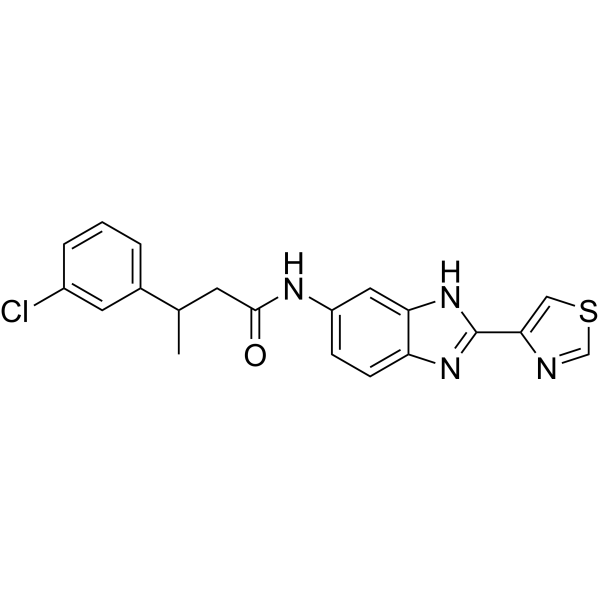
-
- HY-155516
-
|
|
Potassium Channel
|
Inflammation/Immunology
|
|
KV1.3-IN-1 (Compound trans-18) is a KV1.3 channel inhibitor (IC50: 230 nM and 26.12 nM in Ltk? cells and PHA-activated T-lymphocytes respectively). KV1.3-IN-1 impairs intracellular Ca 2+ signaling. KV1.3-IN-1 inhibits T-cell activation, proliferation, and colony formation .
|
-
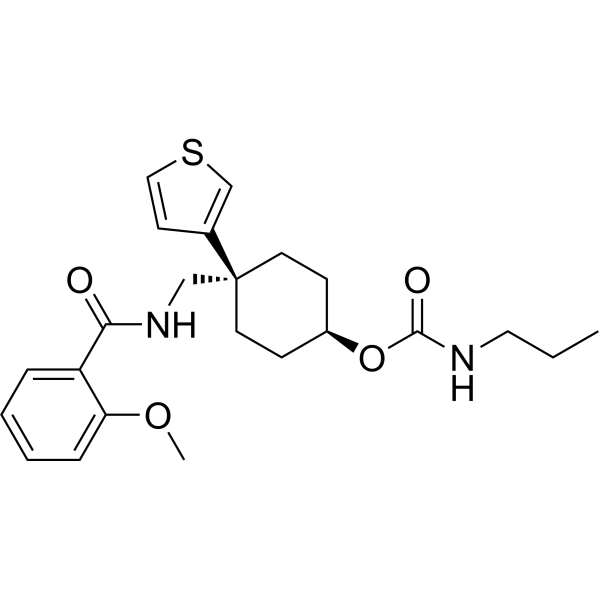
-
- HY-153746
-
|
|
Potassium Channel
|
Inflammation/Immunology
|
|
Kv3 modulator 5 (Example 5) is a Kv3 channel modulator. Kv3 modulator 5 increases the Kv3.2 current. Kv3 modulator 5 can be used for research of hearing disorders .
|
-
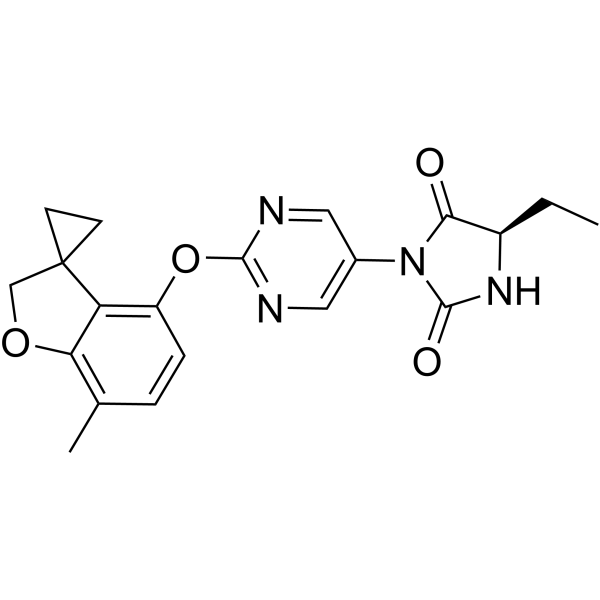
-
- HY-128830
-
|
|
Potassium Channel
|
Inflammation/Immunology
|
|
Kv3 modulator 3 (Compound 4) is a selective modulator of Kv3.1 and/or Kv3.2 and/or Kv3.3 channels extracted from patent WO2017098254A1, compound 4, has analgesic activity for use in the prophylaxis o or treatment of pain .
|
-

-
- HY-128831
-
-

-
- HY-161104
-
|
|
Potassium Channel
|
Neurological Disease
|
|
Kv2.1-IN-1 (compound 80) is a potent inhibitor of Kv2.1, with the IC50 value of 0.07 μM, selectivity >130 fold over other K +, Na +, and Ca 2+ ion channels .
|
-

-
- HY-163018
-
-

-
- HY-111996
-
|
|
Potassium Channel
|
Inflammation/Immunology
|
|
Kv3 modulator 1 is a Kv3 voltage-gated potassium channel modulator extracted from patent WO2018020263A1, Compound X. Kv3 modulator 1 has the potential for inflammatory pain treatment .
|
-
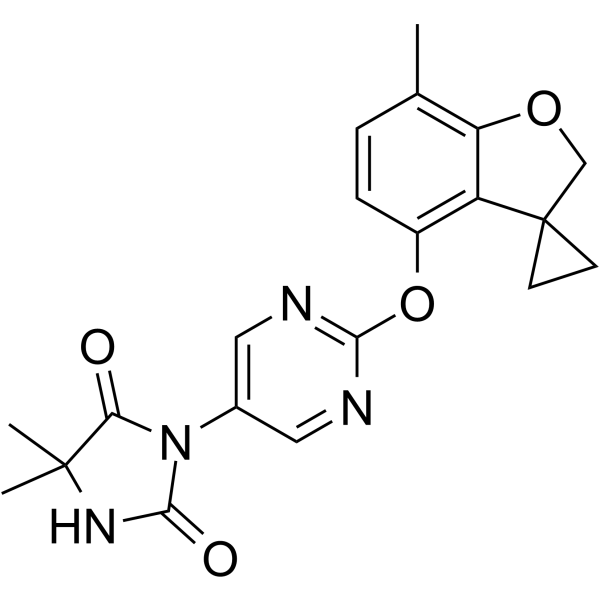
-
- HY-128829
-
|
|
Potassium Channel
|
Inflammation/Immunology
|
|
Kv3 modulator 2 (formula (I)) is a potent Kv3 channels modulator extracted from patent WO2018109484A1, compound formula (I) , has analgesic activity and is used in the prophylaxis or treatment of related disorders .
|
-
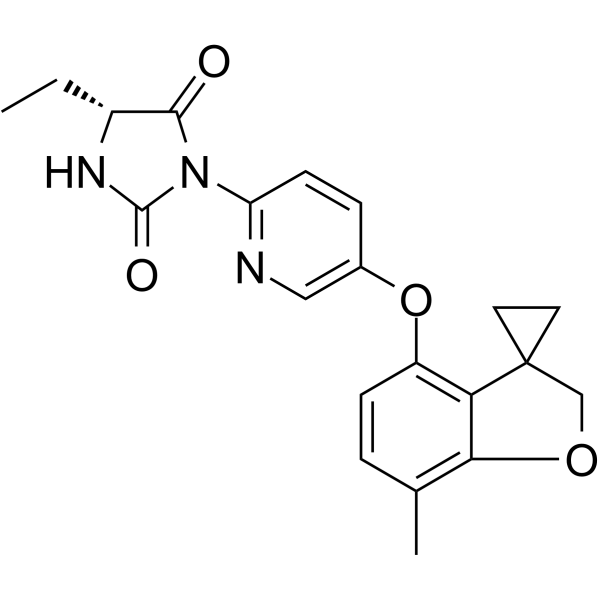
-
- HY-14186
-
|
WYE-160020
|
Potassium Channel
|
Cardiovascular Disease
|
|
KVI-020 is an orally active, potent and selective blocker of the atrial potassium channel Kv1.5, with an IC50 of 480 nM. KVI-020 can inhibits hERG, with an IC50 of 15100 nM. KVI-020 is a potent antiarrhythmic agent, and can be used for atrial fibrillation (AF) research .
|
-
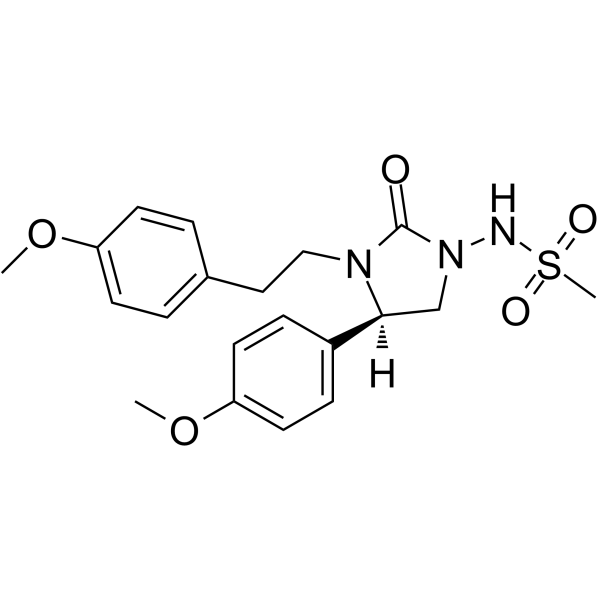
-
- HY-B0267
-
|
|
mAChR
Potassium Channel
|
Neurological Disease
|
|
Oxybutynin is an anticholinergic agent, which inhibits vascular Kv channels in a concentration-dependent manner, with an IC50 of 11.51 μM . Oxybutynin is a click chemistry reagent, it contains an Alkyne group and can undergo copper-catalyzed azide-alkyne cycloaddition (CuAAc) with molecules containing Azide groups.
|
-
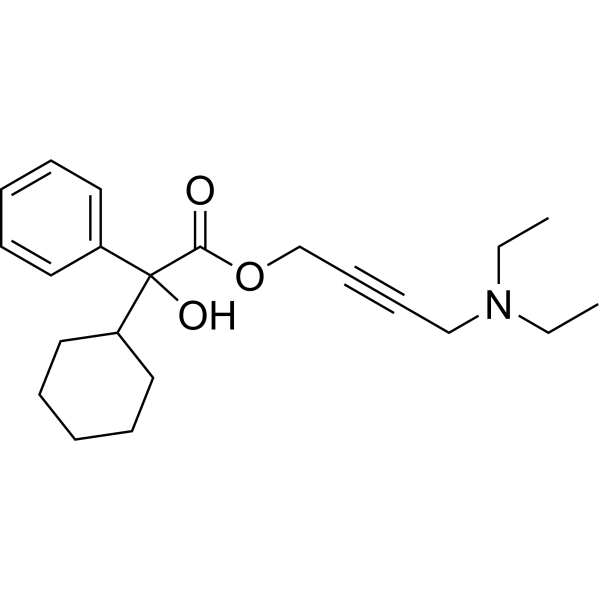
-
- HY-P1281
-
|
|
Potassium Channel
|
Neurological Disease
|
|
Kaliotoxin is a peptidyl inhibitor of neuronal BK-Type. Kaliotoxin can specific inhibit Kv channels and calcium-activated potassium channels. Kaliotoxin can be used for the research of the regulation of membrane potential and neuron excitability .
|
-

-
- HY-101843
-
-
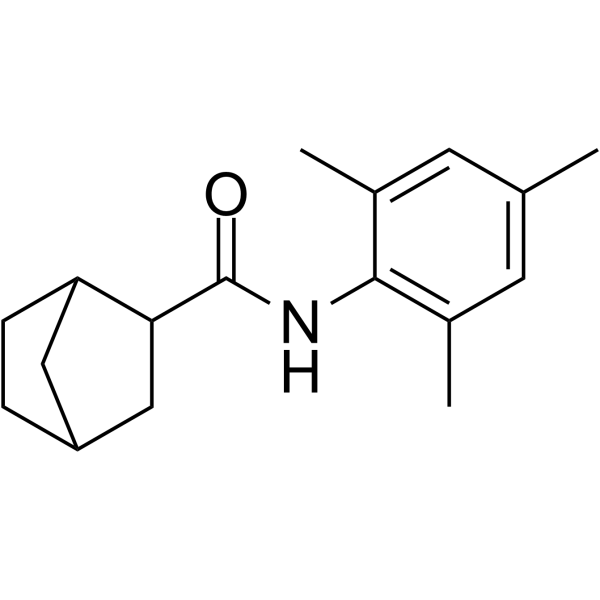
-
- HY-P3014
-
|
|
Potassium Channel
|
Others
|
|
Hongotoxin-1, isolated from venom of Centruroides limbatus, is the inhibitor of potassium channel, with IC50 for? Kv1.1, Kv1.2, Kv1.3, and Kv1.6 of 31 pM, 170 pM, 86 pM,and 6000 pM, respectively .
|
-
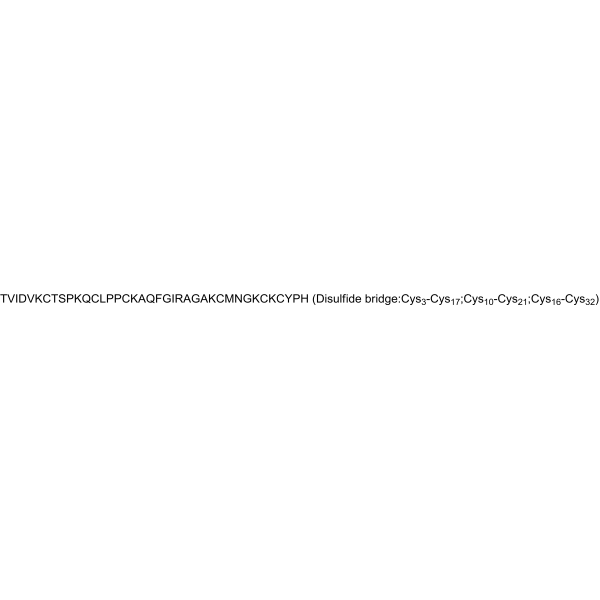
-
- HY-14946
-
|
3,4-Diaminopyridine
|
Potassium Channel
|
Neurological Disease
|
|
Amifampridine (3,4-Diaminopyridine) is an orally active, potent and cell permeable voltage-gated potassium (Kv) channel blocker (PCB). Amifampridine is efficacy in the reversal of BoNT/A (HY-P79153) intoxication. Amifampridine increases transmitter release from neuromuscular junctions (NMJs). Amifampridine can be used for Lambert-Eaton myasthenic syndrome (LEMS) research .
|
-
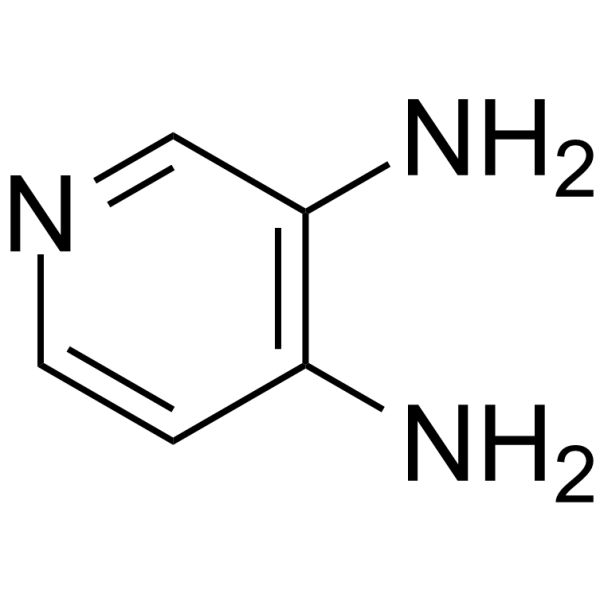
-
- HY-14946A
-
|
3,4-Diaminopyridine phosphate
|
Potassium Channel
|
Neurological Disease
|
|
Amifampridine (3,4-Diaminopyridine) phosphate is an orally active, potent and cell permeable voltage-gated potassium (Kv) channel blocker (PCB). Amifampridine phosphate is efficacy in the reversal of BoNT/A (HY-P79153) intoxication. Amifampridine phosphate increases transmitter release from neuromuscular junctions (NMJs). Amifampridine phosphate can be used for Lambert-Eaton myasthenic syndrome (LEMS) research .
|
-
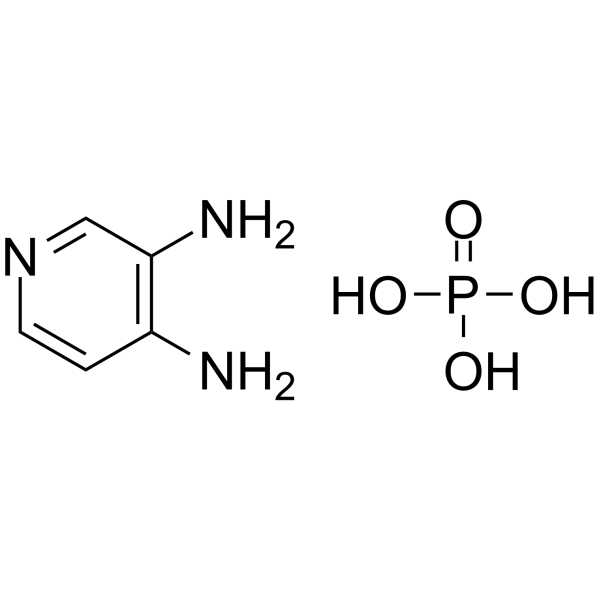
-
- HY-108577
-
|
|
Potassium Channel
|
Neurological Disease
|
|
XE991 dihydrochloride, a Kv7 (KCNQ) channels blocker, potently inhibits Kv7.1 (KCNQ1), Kv7.2 (KCNQ2), Kv7.2 + Kv7.3 (KCNQ3) channel, and M-current with IC50s of 0.75 µM, 0.71 µM, 0.6 μM, and 0.98 µM, respectively .
|
-
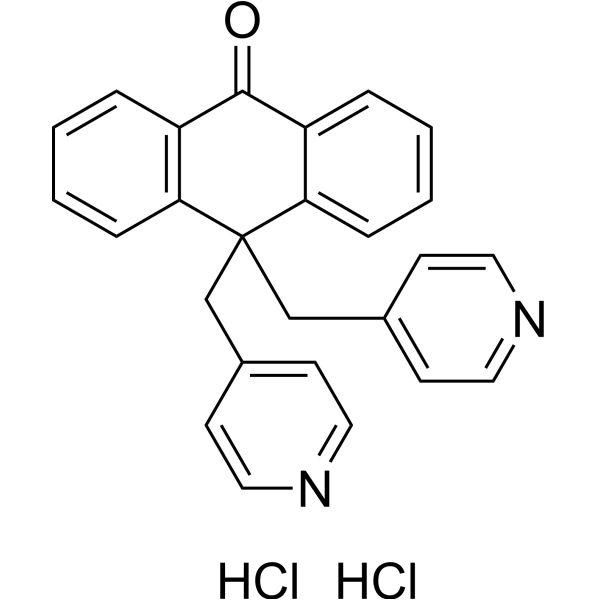
-
- HY-108577A
-
|
|
Potassium Channel
|
Neurological Disease
|
|
XE 991 dihydrochloride, a Kv7 (KCNQ) channels blocker, potently inhibits Kv7.1 (KCNQ1), Kv7.2 (KCNQ2), Kv7.2 + Kv7.3 (KCNQ3) channel, and M-current with IC50s of 0.75 μM, 0.71 μM, 0.6 μM, and 0.98 μM, respectively .
|
-

-
- HY-P2786A
-
-
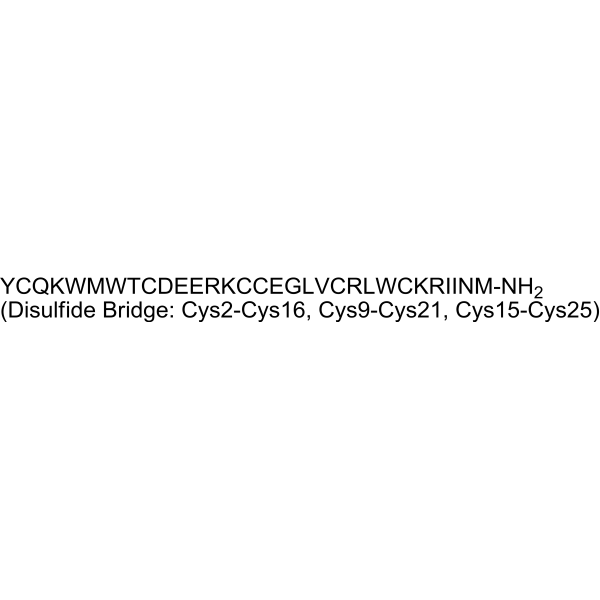
-
- HY-P5788
-
|
|
Potassium Channel
|
Neurological Disease
|
|
Hemitoxin, a scorpion-venom peptide, is a K + channel blocker. Hemitoxin blocks rat Kv1.1, Kv1.2 and Kv1.3 channels expressed in Xenopus oocytes with IC50 values of 13 nM, 16 nM and 2 nM, respectively .
|
-
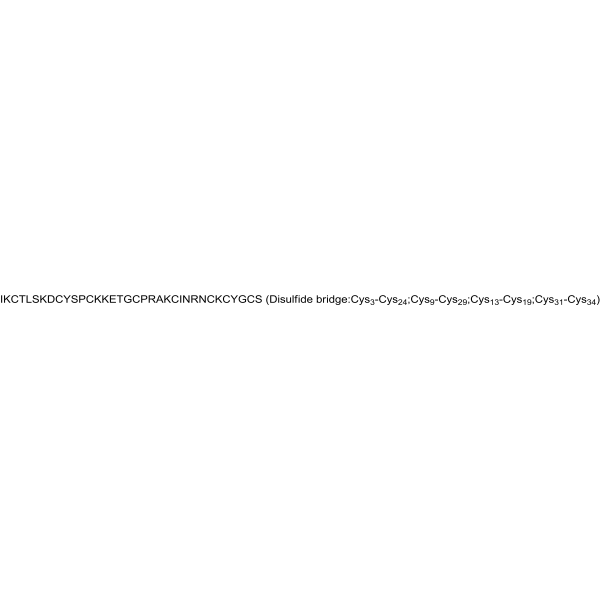
-
- HY-P1427
-
|
|
Potassium Channel
|
Neurological Disease
|
|
Guangxitoxin 1E is a potent and selective blocker of KV2.1 and KV2.2 channels. Guangxitoxin 1E inhibits KV2 with an IC50 of 1-3 nM. KV2 channels underlie delayed-rectifier potassium currents in various neurons .
|
-
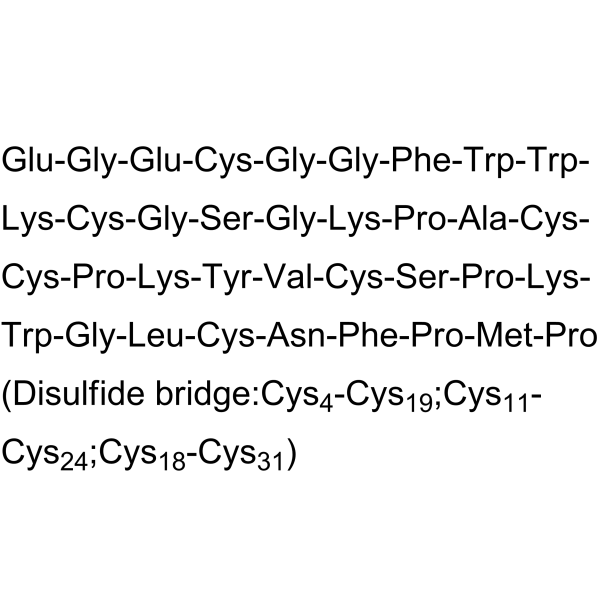
-
- HY-108588
-
|
|
Potassium Channel
|
Cardiovascular Disease
|
|
NS5806, a potent potassium current activator, increases KV4.3/KChIP2 peak current amplitudes with an EC50 of 5.3 μM. NS5806 slows KV4.3 and KV4.2 current dacay in channel complexes containing KChIP2 .
|
-

-
- HY-P5873
-
|
JZTX-X
|
Potassium Channel
|
Neurological Disease
|
|
Jingzhaotoxin-X (JZTX-X) is a selective Kv4.2 and Kv4.3 potassium channels inhibitor. Jingzhaotoxin-X causes long-lasting mechanical hyperalgesia .
|
-
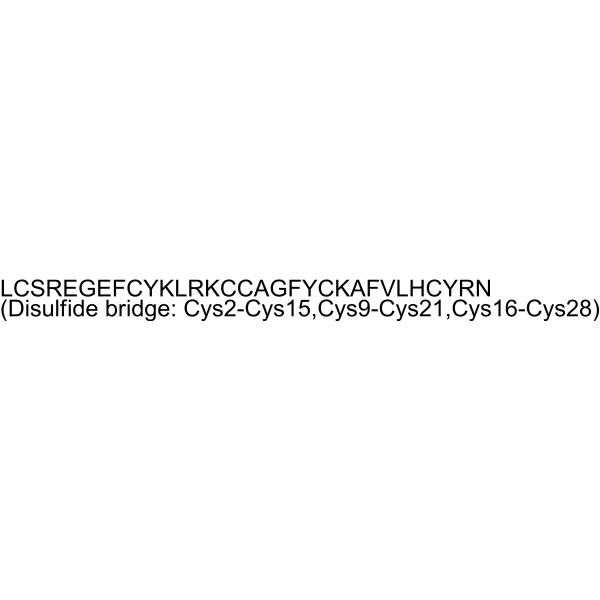
-
- HY-14183
-
|
RSD1235 hydrochloride
|
Potassium Channel
|
Cardiovascular Disease
|
|
Vernakalant hydrochloride is a mixed voltage- and frequency-dependent Na + and atria-preferred K + channel blocker. IC50 for block by Vernakalant of wild-type and mutant Kv1.5 channels Fractional block is 13.35±0.93 μM, 0.61±0.03 μM, and 1.63±0.09 μM for Kv1.5 channel wt, Kv1.5 channel I508F, Kv1.5 channel T479A, respectively.
|
-
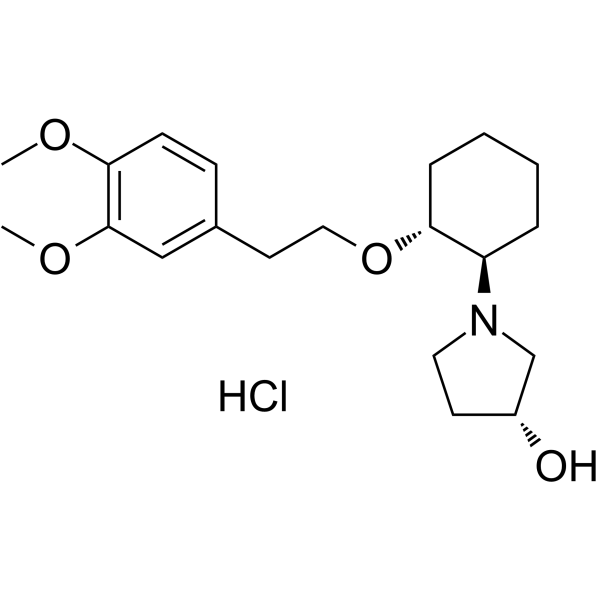
-
- HY-P5870
-
|
|
Potassium Channel
|
Inflammation/Immunology
|
|
KTX-Sp2 is a potassium channel toxin. KTX-Sp2 effectively blocks three types of exogenous voltage-gated potassium channels: Kv1.1, Kv1.2 and Kv1.3. Ktx-Sp2 inhibits endogenous Kv1.3 and suppresses Ca 2+ signaling in Jurkat T cells. Ktx-Sp2 inhibits IL-2 secretion from activated Jurkat T cells .
|
-

-
- HY-B0267A
-
|
|
mAChR
Potassium Channel
|
Neurological Disease
|
|
Oxybutynin chloride is an oral active and competitive mAChR antagonist with Kis of 14.3 and 5.55 nM for specific [ 3H]NMS binding in the mouse bladder and cerebral cortex, respectively. Oxybutynin chloride inhibits vascular Kv channels in a manner independent of anticholinergic effect, with an IC50 value of 11.51 μM. Oxybutynin chloride reduces muscle spasm in the bladder and urinary tract, can be used in study of overactive bladder syndrome (OAB) . Oxybutynin (chloride) is a click chemistry reagent, it contains an Alkyne group and can undergo copper-catalyzed azide-alkyne cycloaddition (CuAAc) with molecules containing Azide groups.
|
-
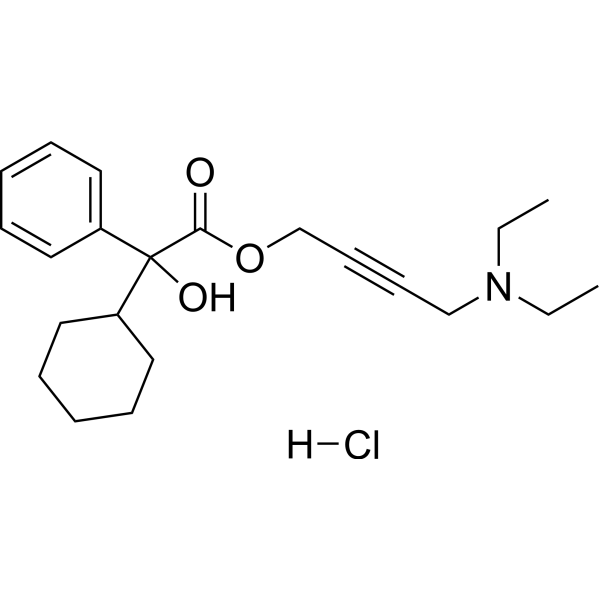
-
- HY-120033
-
|
|
Sodium Channel
|
Neurological Disease
|
|
RY796 is a potent and selective voltage-gated potassium (KV2) channel inhibitor with IC50s of 0.25 μM and 0.09 μM for KV2.1 and KV2.2. RY796 has analgesic activity .
|
-
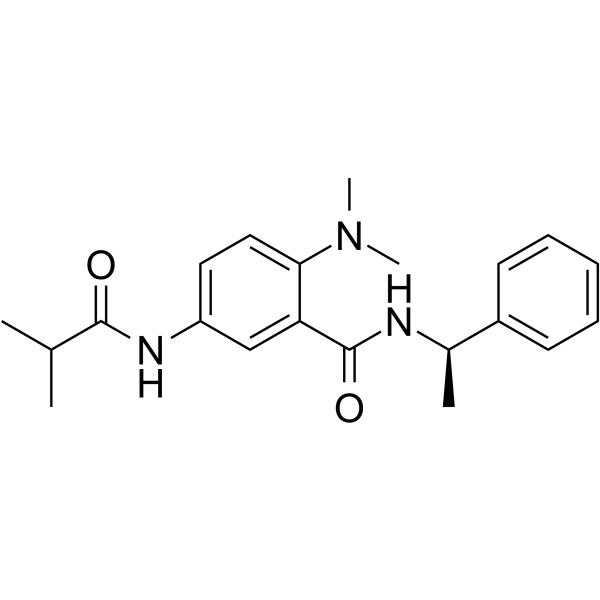
-
- HY-P3316
-
|
|
Potassium Channel
|
Neurological Disease
Inflammation/Immunology
|
|
OSK-1 is a potent Kv channel blocker with IC50s of of 0.6 nM, 5.4 nM, 0.014 nM for Kv1.1, Kv1.2 and Kv1.3, respectively. OSK1 is a moderate blocker of Ca 2+-activated KCa3.1 channel with an IC50 of 225 nM. OSK-1 belongs to α-KTx3 toxins and is used as a immunosuppressive agent .
|
-

-
- HY-P5853
-
|
|
Potassium Channel
|
Inflammation/Immunology
|
|
Aam-KTX is a Kv channel inhibitor with IC50 values of 1.1 nM and >750 nM for Kv1.3 and Kv1.1, respectively. Aam-KTX is a toxic peptide obtained from the venom of the scorpion Mesobuthus eupeus. Aam-KTX has potential in autoimmune diseases research .
|
-
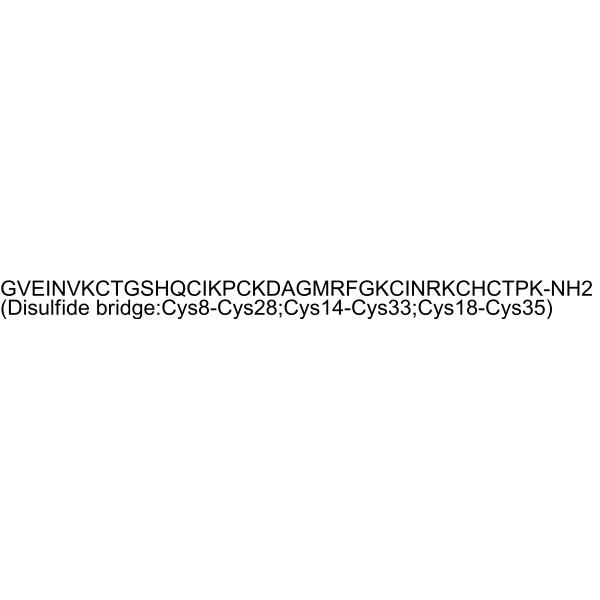
-
- HY-110358
-
|
|
Sodium Channel
|
Inflammation/Immunology
|
|
QAQ dichloride, a photoswitchable voltage-gated Nav and Kv channels blocker, blocks channels in its trans form (of the azobenzene photoswitch), but not in its cis form. QAQ dichloride is membrane-impermeant and only infiltrates pain-sensing neurons that express endogenous import channels. QAQ dichloride acts as a light-sensitive analgesic and can be used for studying of signaling mechanisms in acute and chronic pain .
|
-
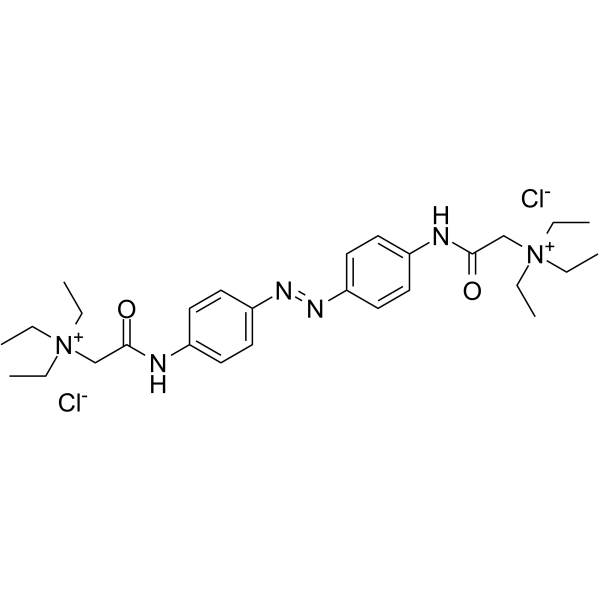
-
- HY-P3055
-
|
DTX-I
|
Potassium Channel
|
Neurological Disease
Cancer
|
|
Dendrotoxin-I is a potent K + channels blocker and targets voltage-gated potassium channel subunits KV1.1 and KV1.2. Dendrotoxin-I is a neurotoxin isolated from thevenom of Dendroaspis snakes .
|
-

-
- HY-110358A
-
|
|
Sodium Channel
|
Inflammation/Immunology
|
|
QAQ dichloride dichloride, a photoswitchable voltage-gated Nav and Kv channels blocker, blocks channels in its trans form (of the azobenzene photoswitch), but not in its cis form. QAQ dichloride dichloride is membrane-impermeant and only infiltrates pain-sensing neurons that express endogenous import channels. QAQ dichloride dichloride acts as a light-sensitive analgesic and can be used for studying of signaling mechanisms in acute and chronic pain .
|
-

-
- HY-P1280
-
|
|
Potassium Channel
|
Neurological Disease
|
|
Margatoxin, an alpha-KTx scorpion toxin, is a high affinity inhibitor of Kv1.3 (Kd=11.7 pM). Margatoxin inhibits the Kv1.2 (Kd=6.4 pM) and Kv1.1 (Kd=4.2 nM). Margatoxin, a 39 amino-acid-long peptide, is isolated from the venom of the scorpion Centruroides margaritatus and widely used in ion channel research .
|
-

-
- HY-P5157
-
|
|
Potassium Channel
|
Neurological Disease
|
|
BmP02 is a selective Kv1.3 channel blocker and a highly-selective Kv4.2 modulator, which can be isolated from Chinese scorpion (Buthus martensi Karsch) venom. BmP02 also delays the inactivation of Kv4.2 in HEK293T cells, with an EC50 value of ~850 nM. BmP02 inhibits the transient outward potassium currents (Ito) in ventricular muscle cells .
|
-
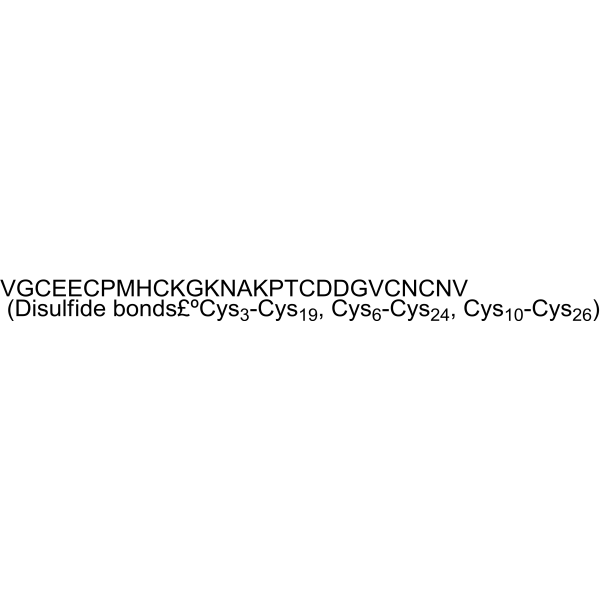
-
- HY-P1280A
-
|
|
Potassium Channel
|
Neurological Disease
|
|
Margatoxin TFA, an alpha-KTx scorpion toxin, is a high affinity inhibitor of Kv1.3 (Kd=11.7 pM). Margatoxin TFA inhibits the Kv1.2 (Kd=6.4 pM) and Kv1.1 (Kd=4.2 nM). Margatoxin TFA, a 39 amino-acid-long peptide, is isolated from the venom of the scorpion Centruroides margaritatus and widely used in ion channel research .
|
-

-
- HY-P5155
-
|
|
Potassium Channel
|
Neurological Disease
|
|
Stromatoxin 1 is an inhibitor of Potassium Channel, a peptide which can be isolated from tarantulas. Stromatoxin 1 selectively inhibits K(V)2.1, K(V)2.2, K(V)4.2, and K(V)2.1/9.3 channels. K(V)2.1 and K(V)2.2, but not K(V)4.2, channel subunits play a key role in opposing both myogenic and neurogenic urinary bladder smooth muscle (UBSM) contractions in rats .
|
-
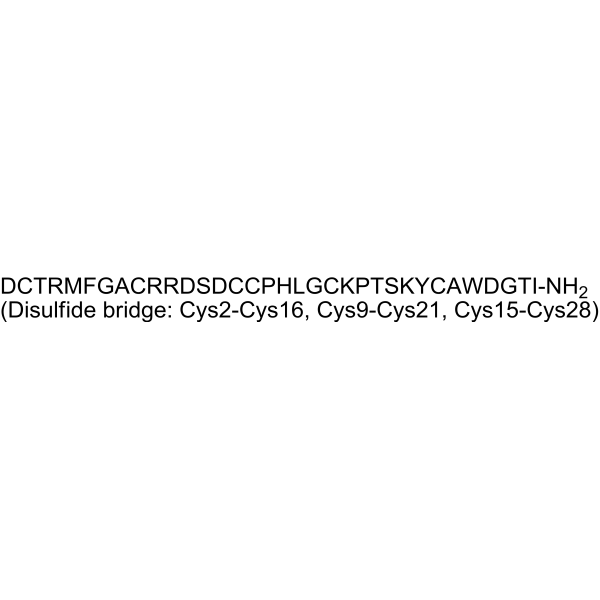
-
- HY-10015
-
|
5-(4-Phenoxybutoxy)psoralen
|
Potassium Channel
|
Inflammation/Immunology
|
|
PAP-1 (5-(4-Phenoxybutoxy)psoralen) is a potent, selective, and orally active Kv1.3 blocker (EC50=2 nM). PAP-1 blocks Kv1.3 in a use-dependent manner and acts by preferentially binding to the C-type inactivated state of the channel. PAP-1 exhibits 23-fold selectivity over Kv1.5 (EC50=45 nM), and further displays 33- to 125-fold selectivity over all other Kv1-family channels. PAP-1 does not exhibit cytotoxic or phototoxic effects .
|
-
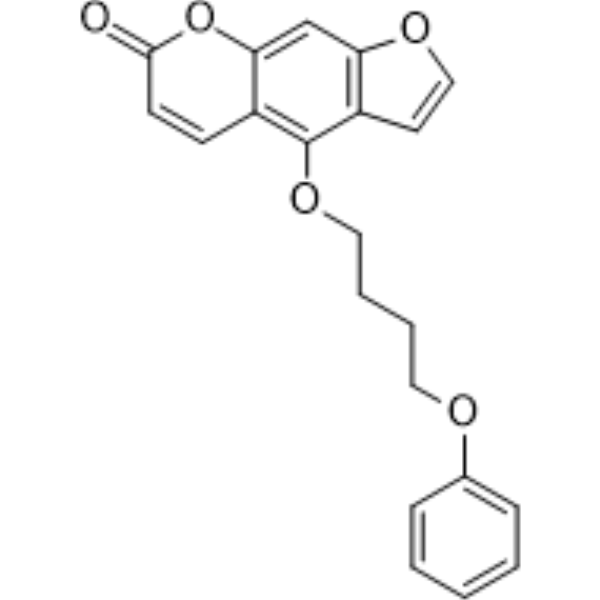
-
- HY-117639
-
|
|
Potassium Channel
|
Neurological Disease
|
|
AUT1 is a recombinant human Kv3 channel modulator. AUT1 modulates Kv3.1b and Kv3.2a channels in human recombinant with pEC50 values of 5.33 and 5.31 μM, respectively. AUT1 can be used for the research of disorders associated with dysfunction of inhibitory feedback in corticolimbic circuits, such as schizophrenia .
|
-
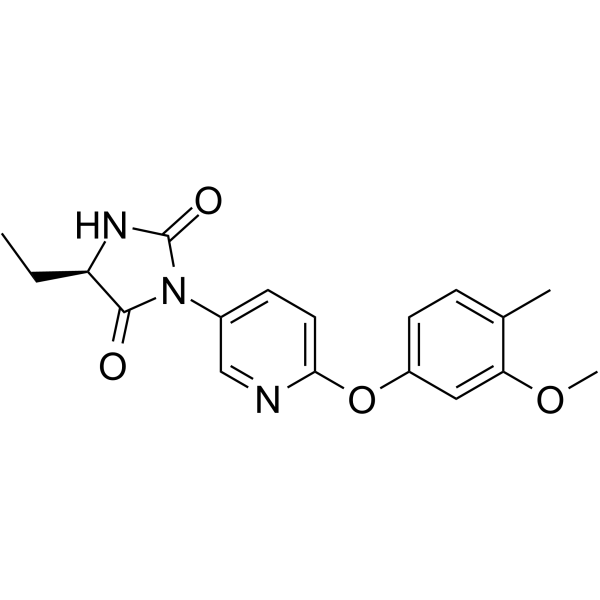
-
- HY-114608
-
|
|
Sodium Channel
|
Neurological Disease
|
|
RY785 is a potent and selective voltage-gated potassium (KV2) channel inhibitor with an IC50 of 0.05 μM for KV2.2. RY785 has analgesic activity .
|
-
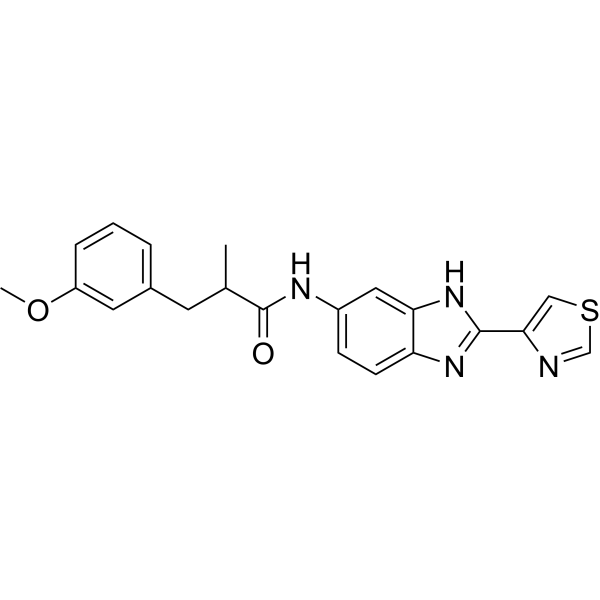
-
- HY-118387
-
|
|
Potassium Channel
|
Neurological Disease
|
|
AVE-0118 is a nonselective Kv1.5 blocker with an IC50 of 1.1 μM. AVE-0118 is a multichannel inhibitor with weak, micromolar activity against Kv1.5 and other ion channels. It is inactive against IKs, IKATP, and L-type Ca+ channels .
|
-
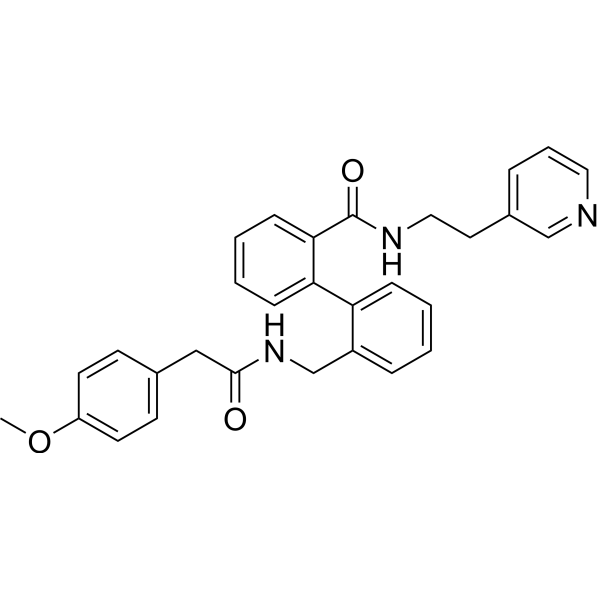
-
- HY-P1440A
-
|
|
Potassium Channel
|
|
|
BeKm-1 TFA is a potent and selective KV11.1 (hERG) channel blocker. BeKm-1 TFA is selective for KV11.1 over a panel of 14 other potassium channels. BeKm-1 TFA dose-dependently prolongs QTc interval in isolated rabbit heart.
|
-
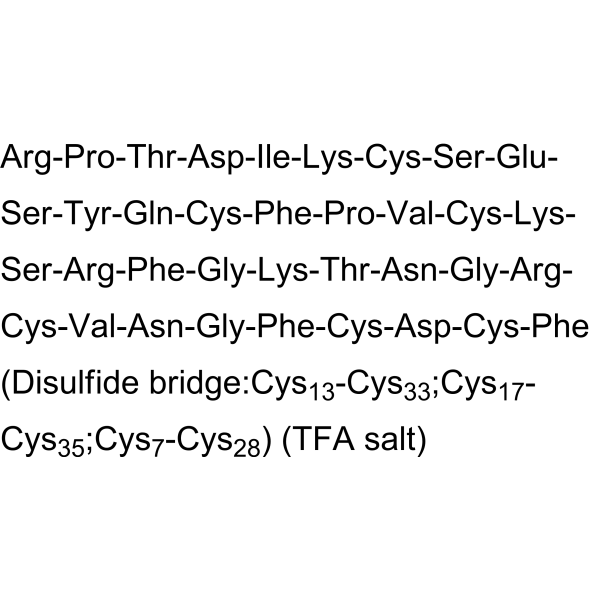
-
- HY-P5828
-
-
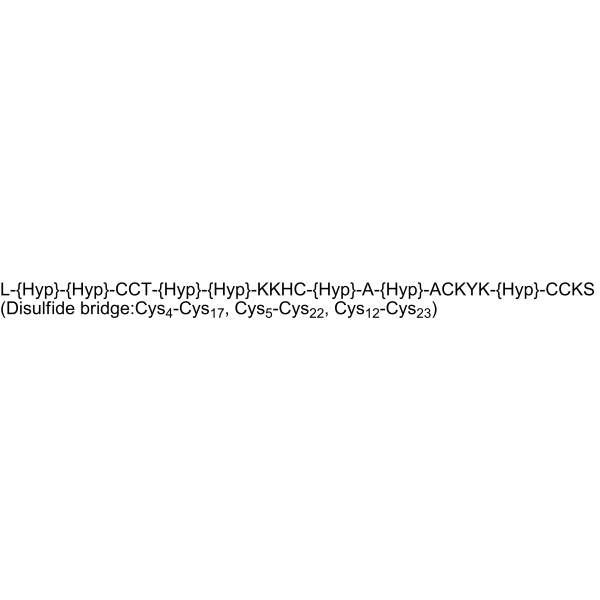
-
- HY-101396
-
|
|
Potassium Channel
|
Neurological Disease
|
|
ICA-069673 is a KCNQ2/Q3 potassium channel activator. ICA-069673 demonstrates greater selectivity for KV7.2/7.3 over KV7.3/KV7.5, with EC50s of 0.69 μM and 14.3 μM, respectively. ICA-069673 inhibits spontaneous phasic and nerve-evoked contractions in guinea pig detrusor smooth muscle (DSM). ICA-069673 also decreases the global intracellular Ca(2+) concentration in DSM cells .
|
-

-
- HY-P5925
-
|
SsTx Toxin
|
Potassium Channel
|
Inflammation/Immunology
|
|
Ssm Spooky Toxin from?Scolopendra mutilans, exhibits lethal toxicity in hematological and respiratory systems by potently inhibiting KCNQ (voltage-gated potassium channel family 7) channels, with IC50? of 2.8 μM, 5.26 μM and 0.1-0.3 M for Kv7.4, Kv1.3, and Shal channel, respectivily. Ssm Spooky Toxin inhibits cytokine generation by specifically acting on the KV1.3 channel in T cells. Ssm Spooky Toxin plays an essential role in the centipede’s circulatory system .
|
-
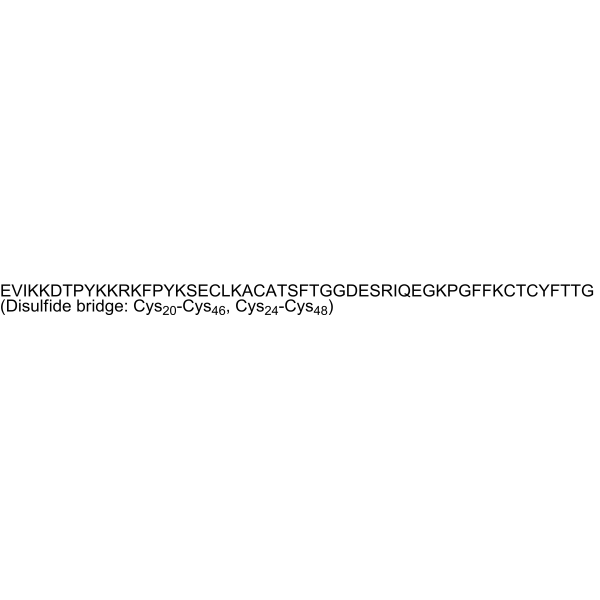
-
- HY-P5771
-
|
|
Sodium Channel
|
Neurological Disease
|
|
Jingzhaotoxin-IX, a C-terminally amidated peptide composed of 35 amino acid residues, is a neurotoxin. Jingzhaotoxin-IX inhibits voltage-gated sodium channels (both tetrodotoxin-resistant and tetrodotoxin-sensitive isoforms) and Kv2.1 channel. Jingzhaotoxin-IX has no effect on delayed rectifier potassium channel Kv1.1, 1.2 and 1.3 .
|
-
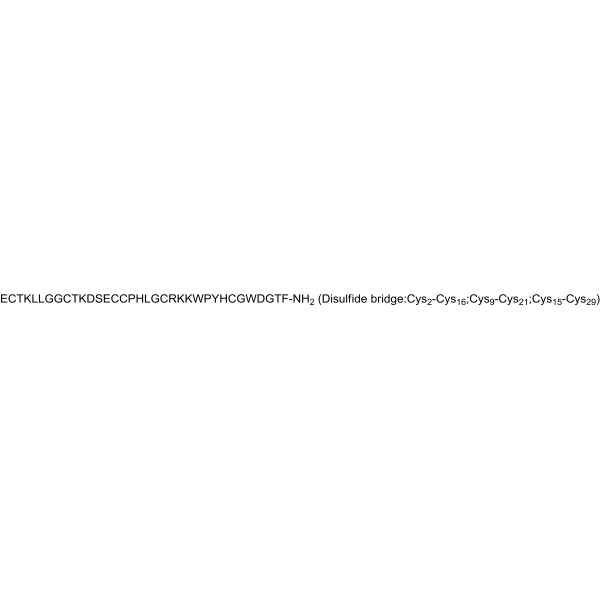
-
- HY-108587
-
|
|
Potassium Channel
|
Neurological Disease
|
|
ICA 110381 is an orally active Kv7.2/Kv7.3 (KCNQ2/3) potassium channel activator with anticonvulsive properties. ICA 110381 is a KCNQ2/Q3 activator (EC50=0.38 μM) as well as KCNQ1 antagonist (IC50=15 μM) .
|
-
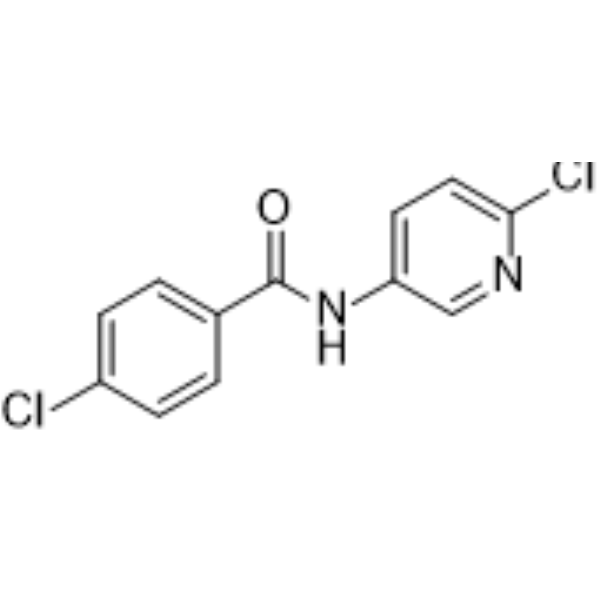
-
- HY-139791
-
|
XEN1101
|
Potassium Channel
|
Cancer
|
|
KCNQ2/3 activator-1 is an activator of Kv7.2/Kv7.3 (KCNQ2/3) potassium channel. KCNQ2/3 activator-1 has the potential in relieving pain (the main problem from medical treatment) (extracted from patent WO2021113757A1, compound A) .
|
-

-
- HY-P5818
-
-

-
- HY-120375
-
-
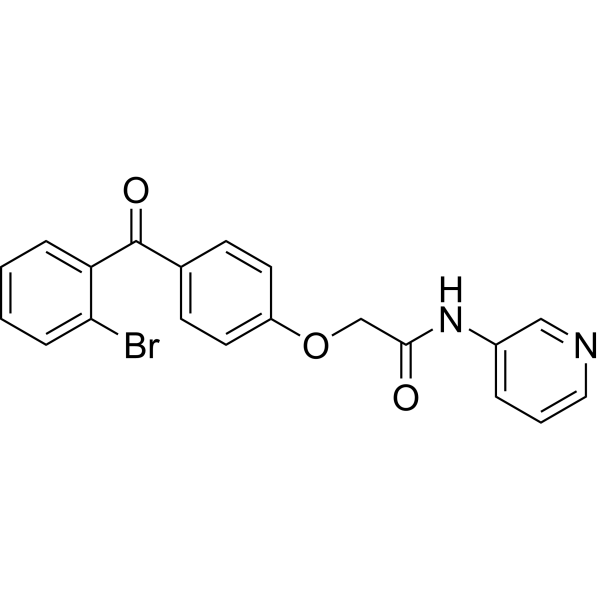
-
- HY-P2785A
-
-
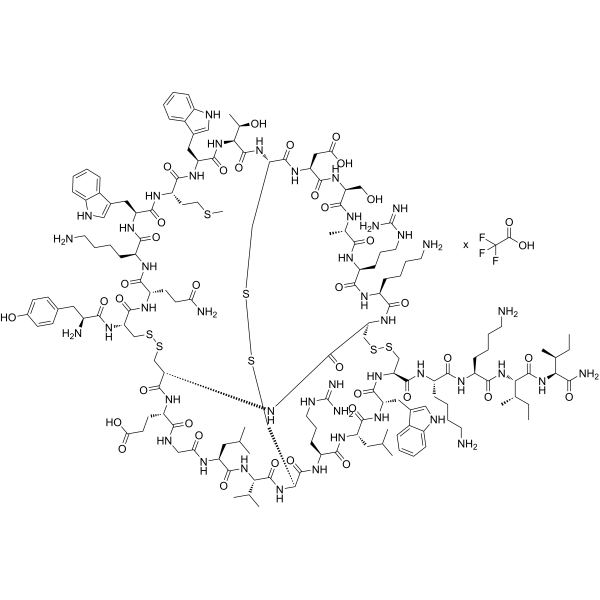
- HY-125469
-
|
PF-04895162
|
Potassium Channel
|
Neurological Disease
|
|
ICA-105665 (PF-04895162) is a potent and orally active neuronal Kv7.2/7.3 and Kv7.3/7.5 potassium channels opener. ICA-105665 inhibits liver mitochondrial function and bile salt export protein (BSEP) transport (IC50 of 311 μM). ICA-105665 can penetrate the blood-brain barrier and has antiseizure effects .
|
-
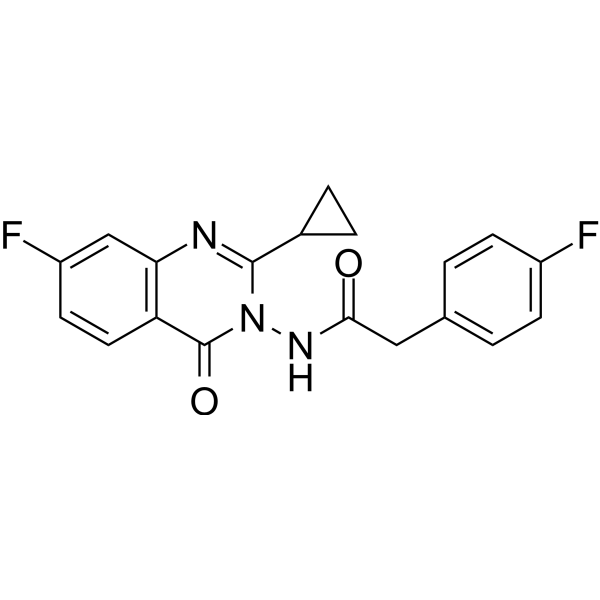
- HY-P1409
-
|
|
Potassium Channel
|
Inflammation/Immunology
|
|
ADWX 1 is a new peptide inhibitor that is potent and selective for Kv1.3 with an IC50 value of 1.89 pM. ADWX 1 inhibits Kv1.3 channel activity specifically to inhibit both the initial calcium signaling and NF-κB activation. ADWX 1 ameliorates the disease in rats of experimental autoimmune encephalomyelitis (EAE) models. ADWX 1 can be used to study T cell-mediated autoimmune diseases .
|
-

- HY-137986
-
|
|
Potassium Channel
|
Inflammation/Immunology
|
|
LUF7244 is a selective allosteric modulator of Kv11.1 channels. LUF7244 inhibits early afterdepolarizations. LUF7244 can be used for anti-arrhythmia research .
|
-
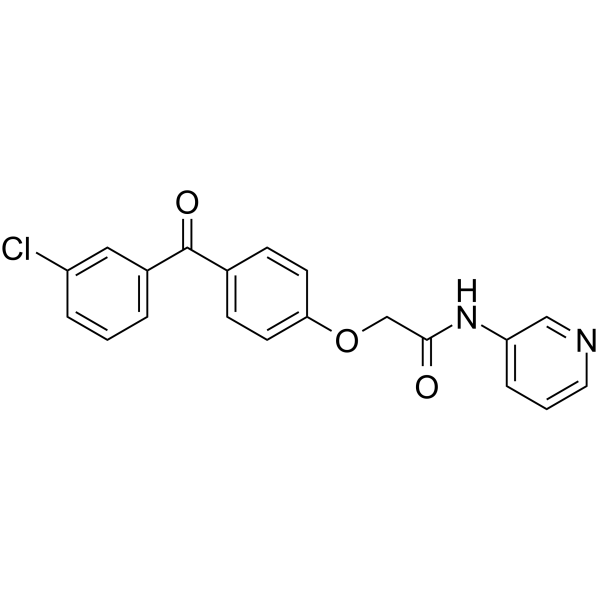
- HY-P5871
-
|
JzTx-XII
|
Potassium Channel
|
Others
|
|
Jingzhaotoxin-XII (JzTx-XII) is a specific Kv4.1 channel inhibitor with an IC50 of 0.363 μM. Jingzhaotoxin-XII interacts with the channels by modifying the gating behavior .
|
-
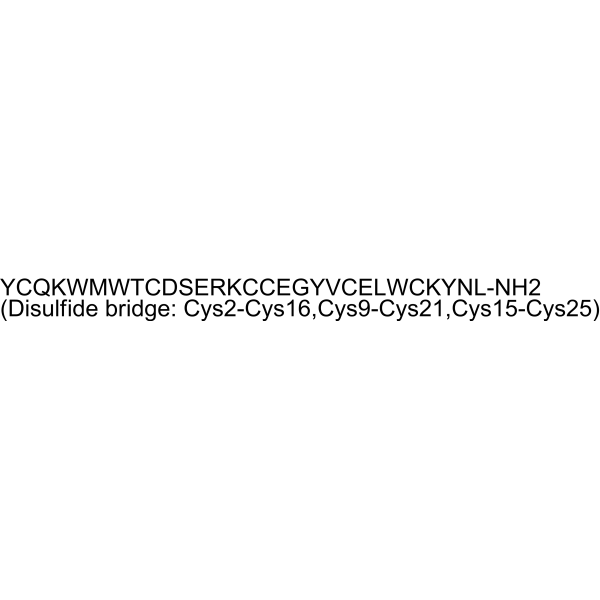
- HY-P5156
-
|
|
Potassium Channel
|
Neurological Disease
|
|
BDS-I known as blood depressing substance, is a marine toxin which can be extracted from Anemonia sulcata. BDS-I is a specific inhibitor of Potassium Channel, targeting to Kv3.4. BDS-I inhibits Aβ1-42-induced enhancement of KV3.4 activity, caspase-3 activation, and abnormal nuclear morphology of NGF-differentiated PC-12 cells. BDS-I reverts the Aβ peptide-induced cell death .
|
-

- HY-P3089
-
|
|
Potassium Channel
|
Others
|
|
Dendrotoxin K is a Kv1.1 channel blocker. Dendrotoxin K determines glutamate release in CA3 neurons in a time-dependent manner through the control of the presynaptic spike waveform .
|
-
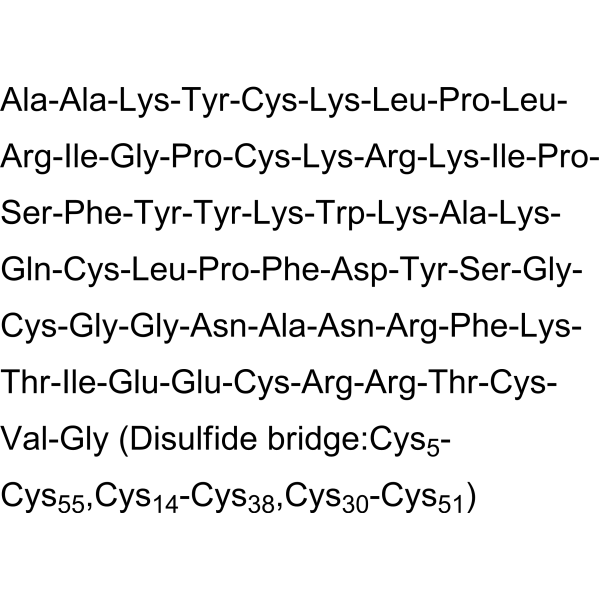
- HY-144802
-
-
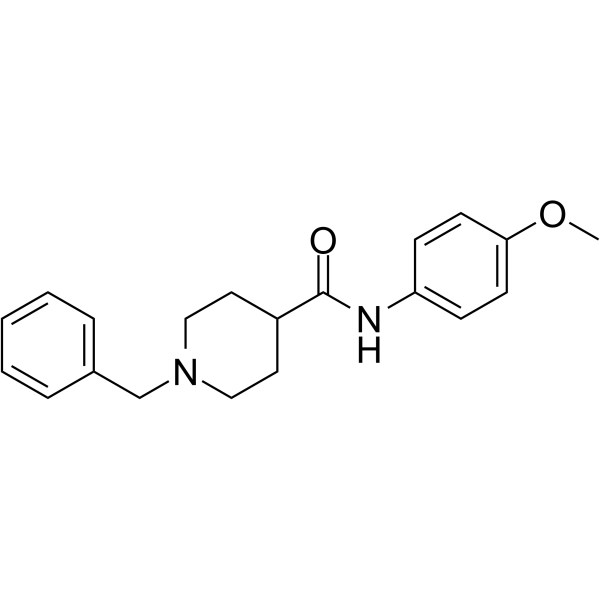
- HY-100712
-
|
|
|
|
|
DPO-1 is a potent inhibitor of the voltage-gated potassium channel subtype Kv1.5 and a blocker of ultrarapid delayed rectifier potassium current. DPO-1 prevents atrial arrhythmia .
|
-
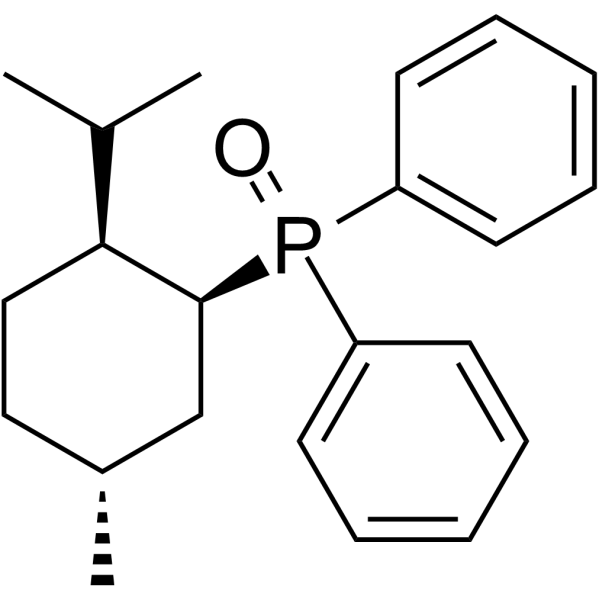
- HY-116759
-
-
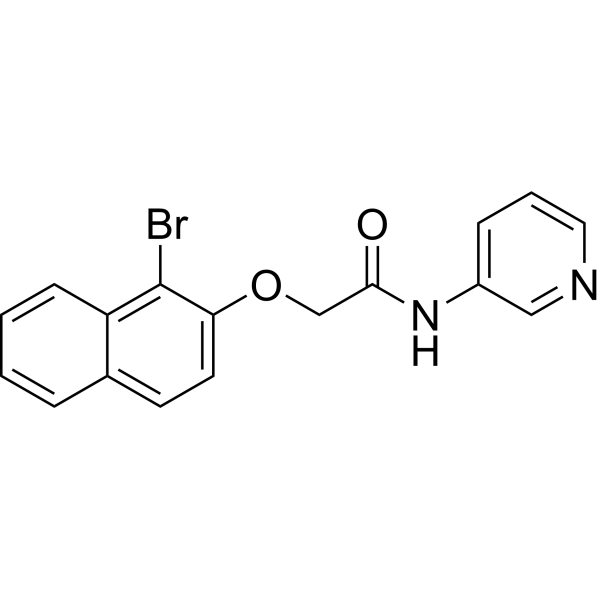
- HY-P3089A
-
|
|
Potassium Channel
|
Others
|
|
Dendrotoxin K TFA is a Kv1.1 channel blocker. Dendrotoxin K TFA determines glutamate release in CA3 neurons in a time-dependent manner through the control of the presynaptic spike waveform .
|
-
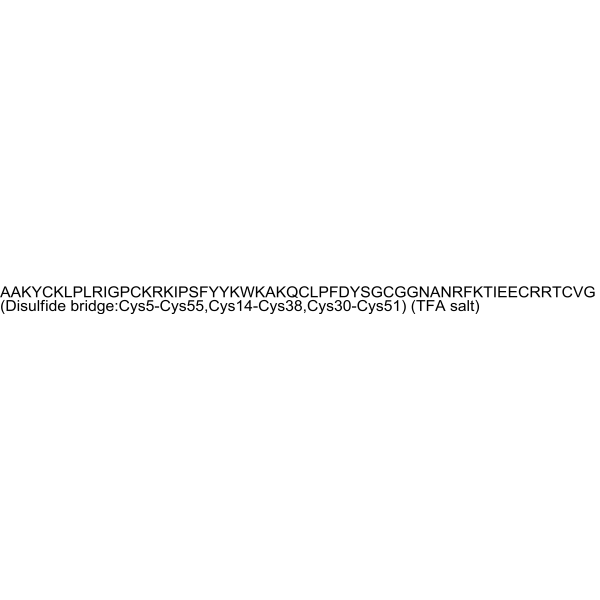
- HY-P5917
-
|
Vaejovis mexicanus peptide 24
|
Potassium Channel
|
Others
|
|
Vm24-toxin is a toxin peptide that can be isolated from the Mexican scorpion Vaejovis mexicanus smithy. Vm24-toxin is an inhibitor of Kv1.3 potassium channel .
|
-
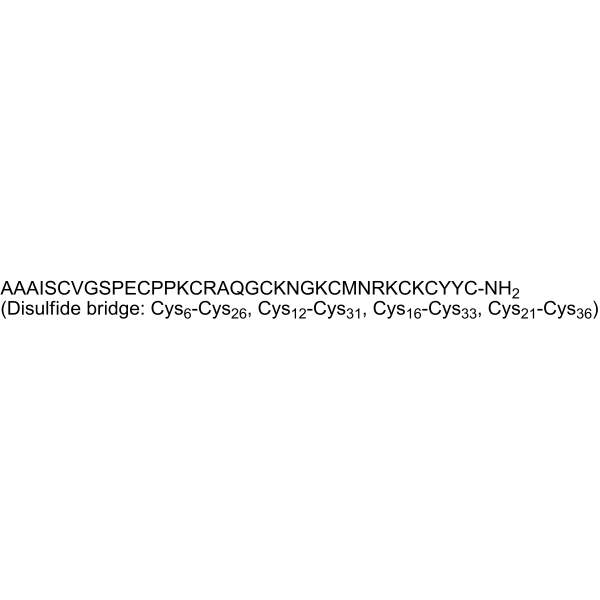
- HY-N8372
-
|
|
Potassium Channel
|
Inflammation/Immunology
|
|
Nalanthalide is a voltage-gated potassium channel Kv1.3 blocker (IC50=3.9 µM) and a potential immunosuppressant. Nalanthalide can be used for research on inflammatory immune diseases, such as neuroinflammation .
|
-
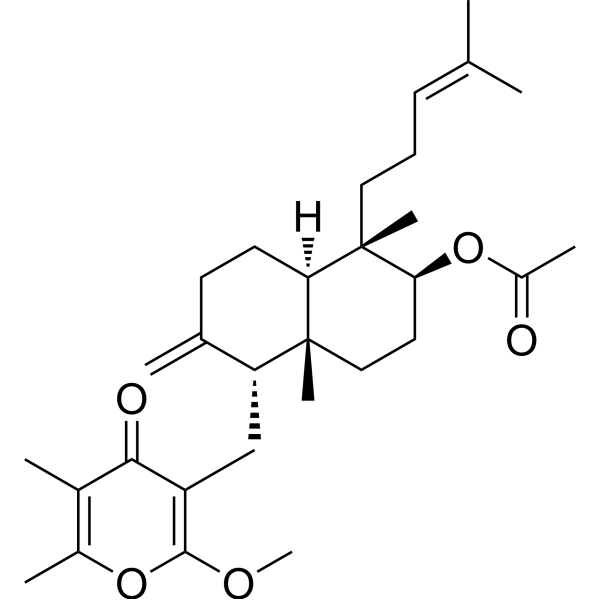
- HY-110162
-
|
|
Potassium Channel
|
Neurological Disease
|
|
QO 58 is a potent modulator of K(v)7 channels. QO-58 increases the current amplitudes, shifts the voltage-dependent activation curve in a more negative direction and slows the deactivation of K(v)7.2/K(v)7.3 currents. QO-58 has the potential for the research of diseases associated with neuronal hyperexcitability .
|
-
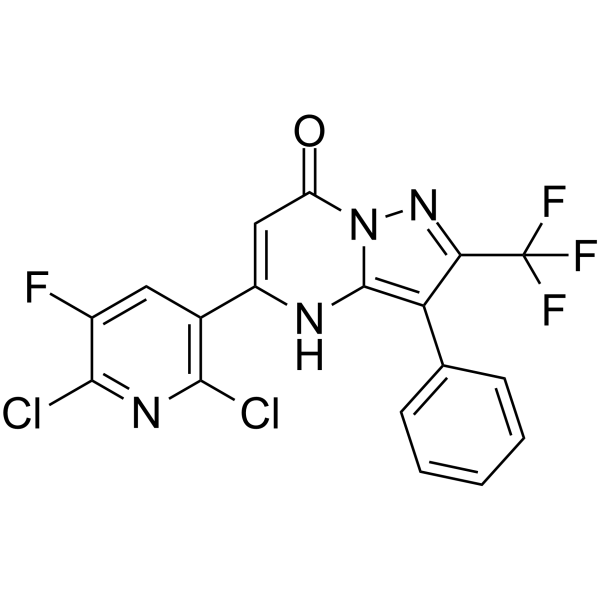
- HY-P2710
-
|
|
Potassium Channel
|
Neurological Disease
Inflammation/Immunology
|
|
Noxiustoxin is a toxin from the venom of the Mexican scorpion Centruroides noxius which block voltage-dependent potassium channel (Kv1.3, IC50 = 360 nM), and calcium-activated potassium channel. Noxiustoxin plays an important role in neuroinflammatory disease .
|
-
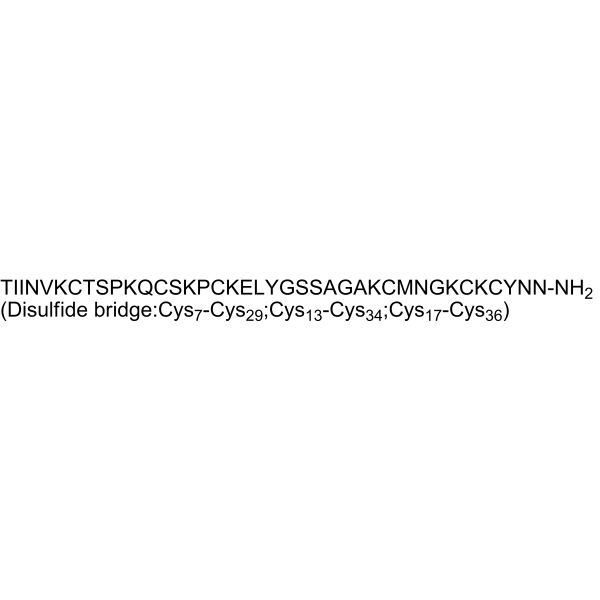
- HY-P5785
-
|
|
Potassium Channel
|
Neurological Disease
|
|
Heteropodatoxin-2, a peptides of 30-amino acid, is a heteropodatoxin. Heteropodatoxin-2 blocks Kv4.2 current expressed in Xenopus laevis oocytes in a voltage-dependent manner, with less block at more positive potentials .
|
-
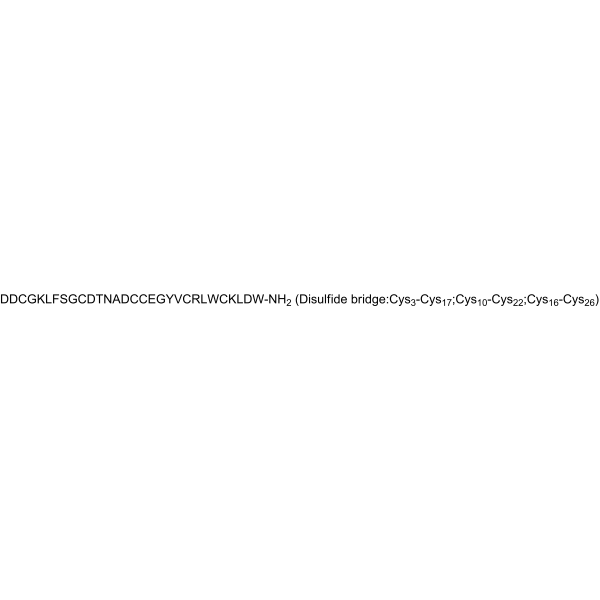
- HY-122015
-
|
|
Potassium Channel
|
Neurological Disease
|
|
ASP2905 is a potent and selective potassium channel Kv12.2 inhibitor encoded by the Kcnh3/BEC1 gene. ASP2905 can cross the blood-brain barrier and has antipsychotic activities .
|
-
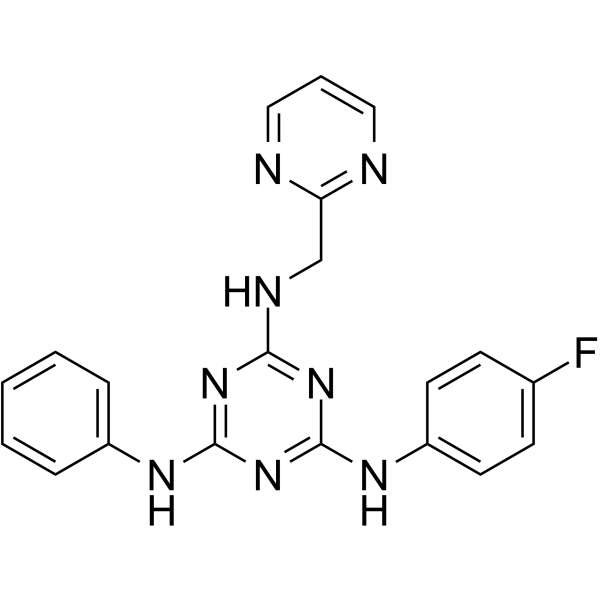
- HY-P5785A
-
|
|
Potassium Channel
|
Neurological Disease
|
|
Heteropodatoxin-2 (TFA), a peptides of 30-amino acid, is a heteropodatoxin. Heteropodatoxin-2 blocks Kv4.2 current expressed in Xenopus laevis oocytes in a voltage-dependent manner, with less block at more positive potentials .
|
-
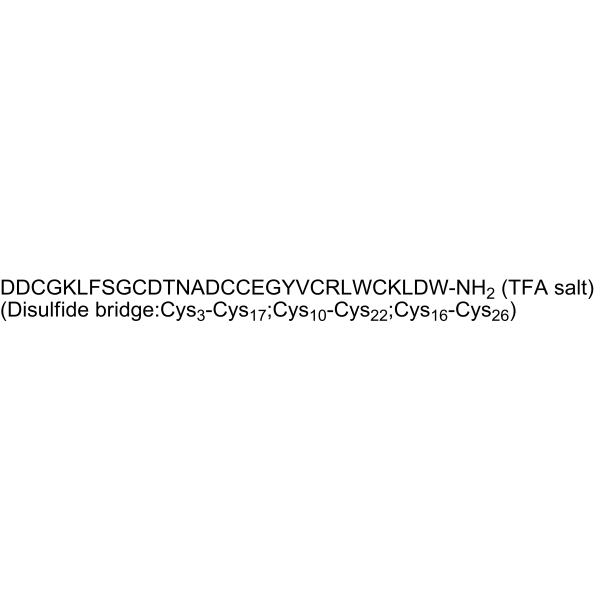
- HY-108584
-
|
BMS-204352
|
Potassium Channel
|
Neurological Disease
|
|
Flindokalner (BMS-204352) is a potassium channel modulator. Flindokalner is a positive modulator of all neuronal Kv7 channel subtypes expressed in HEK293 cells. Flindokalner is also a large conductance calcium-activated K channel (BKca) positive modulator. Flindokalner shows a negative modulatory activity at Kv7.1 channels (Ki=3.7 μM), and acts as a negative modulator of GABAA receptors. Flindokalner shows anxiolytic efficacy in vivo .
|
-

- HY-108583
-
|
5-(4-Phenylbutoxy)psoralen
|
Potassium Channel
|
Inflammation/Immunology
|
|
Psora-4 is a potent and selective inhibitor of Kv1.3 (voltage-gated potassium channels) with an EC50 of 3 nM . Psora-4 has immunosuppressive activity and inhibits proliferation of human and rat myelin-specific effector memory T cells in vitro .
|
-
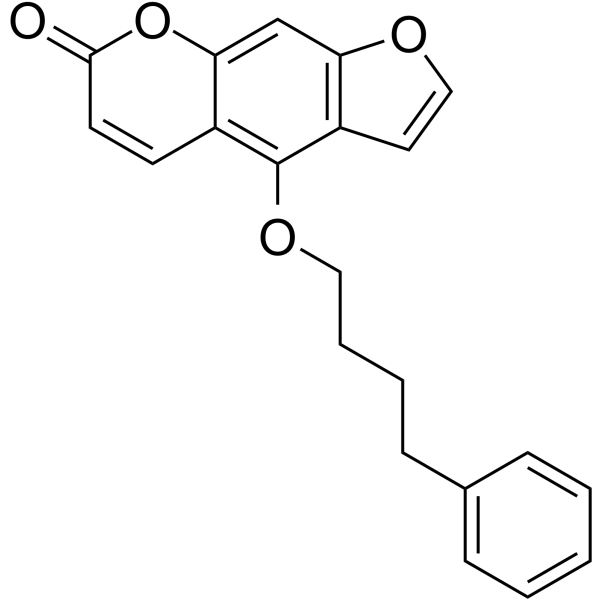
- HY-P3507
-
|
ShK-186
|
Potassium Channel
|
Metabolic Disease
Inflammation/Immunology
|
|
Dalazatide (ShK-186) is a specific Kv1.3 potassium channel peptide inhibitor. Dalazatide can be used in the study of autoimmune diseases such as multiple sclerosis (MS), lupus erythematosus, psoriasis, rheumatoid arthritis, type 1 diabetes and inflammatory bowel disease .
|
-

- HY-P5786
-
-
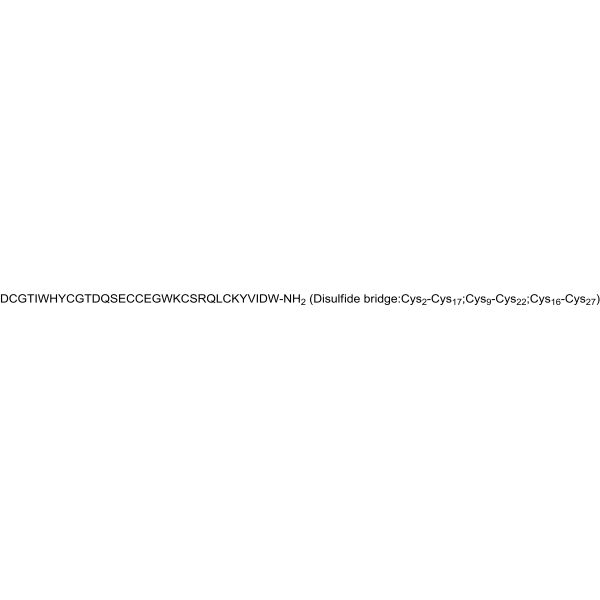
- HY-P3507A
-
|
ShK-186 TFA
|
Potassium Channel
|
Metabolic Disease
Inflammation/Immunology
|
|
Dalazatide (ShK-186) TFA is a specific Kv1.3 potassium channel peptide inhibitor. Dalazatide TFA can be used in the study of autoimmune diseases such as multiple sclerosis (MS), lupus erythematosus, psoriasis, rheumatoid arthritis, type 1 diabetes and inflammatory bowel disease .
|
-
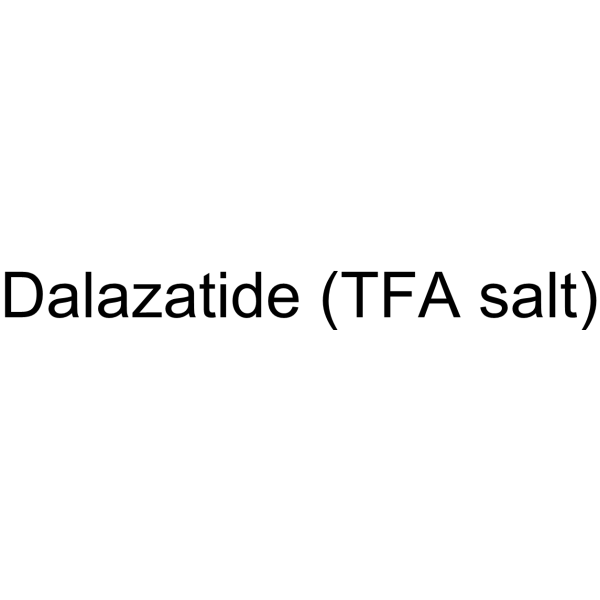
- HY-P5931
-
|
Potassium channel toxin alpha-KTx 6.13; SPX; α-KTx6.13
|
Potassium Channel
|
Inflammation/Immunology
|
|
Spinoxin isolated from the venom of scorpion Heterometrus spinifer, is a 34-residue peptide neurotoxin cross-linked by four disulfide bridges. Spinoxin is a potent inhibitor of Kv1.3 potassium channel (IC50 = 63 nM), considering to be valid molecular targets in the diagnostics and therapy of various autoimmune disorders and cancers .
|
-
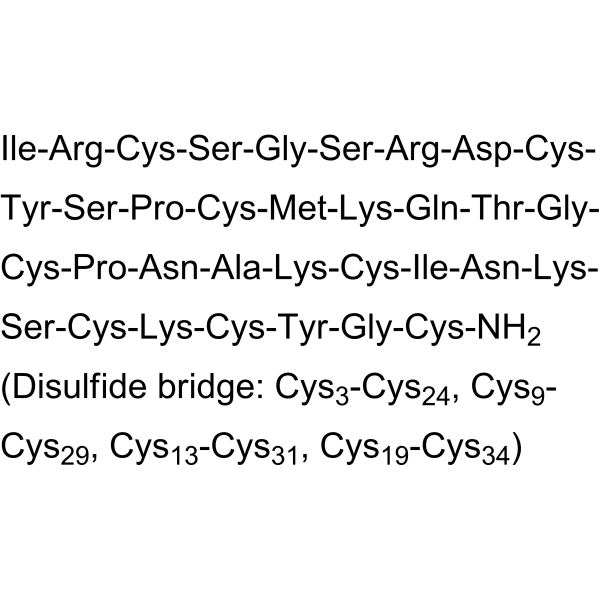
- HY-W013727
-
|
|
Potassium Channel
|
Inflammation/Immunology
|
|
UK-78282, a novel piperidine, potent and selective Kv1.3 blocker with an IC50 of 200 nM. UK-78,282 effectively suppresses human T-lymphocyte activation in vitro. UK-78,282 binds to residues at the inner surface of the channel overlapping the site of action of verapamil .
|
-

- HY-P5182
-
|
|
Potassium Channel
|
Inflammation/Immunology
|
|
HsTX1, from the scorpion Heterometrus spinnifer, is a 34-residue, C-terminally amidated peptide cross-linked by four disulfide bridges. HsTX1, an the inhibitor of potassium channel, with IC50 for Kv1.3 of 12 pM inhibits TEM cell activation and attenuates inflammation in autoimmunity .
|
-

- HY-108586
-
|
|
Potassium Channel
|
Neurological Disease
|
|
NS3623 is an activator of human ether-a-go-go-related gene (hERG1/KV11.1) potassium channels. NS3623 activates the IKr and Ito currents and has antiarrhythmic effect. NS3623 has a dual mode of action, being an inhibitor of hERG1 channels .
|
-

- HY-144801A
-
|
|
Potassium Channel
|
Cardiovascular Disease
|
|
DDO-02005 is a potent Kv1.5 potassium channel inhibitor with an IC50 value of 0.72 μM. DDO-02005 has good anti-atrial fibrillation (AF) effect in CaCl2-ACh AF rats model and effective anti-arrhythmic activity caused by aconitine .
|
-
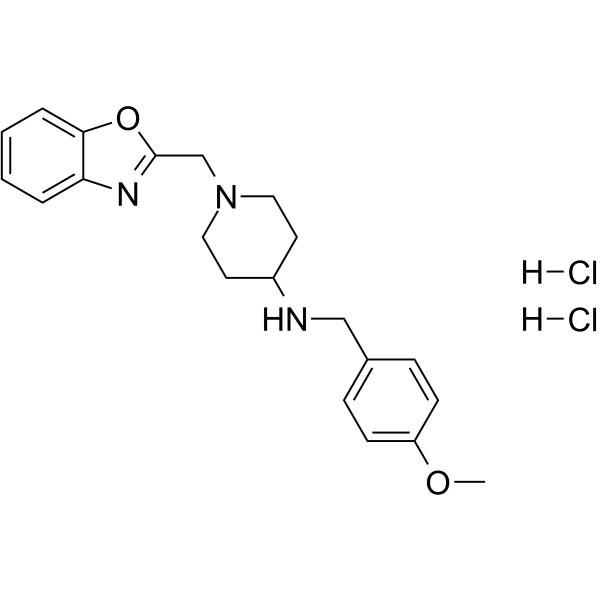
- HY-P5182A
-
|
|
Potassium Channel
|
Inflammation/Immunology
|
|
HsTX1 (TFA) toxin, from the scorpion Heterometrus spinnifer, is a 34-residue, C-terminally amidated peptide cross-linked by four disulfide bridges. HsTX1 (TFA) is an the inhibitor of potassium channel, with IC50 for Kv1.3 of 12 pM and inhibits TEM cell activation and attenuates inflammation in autoimmunity .
|
-
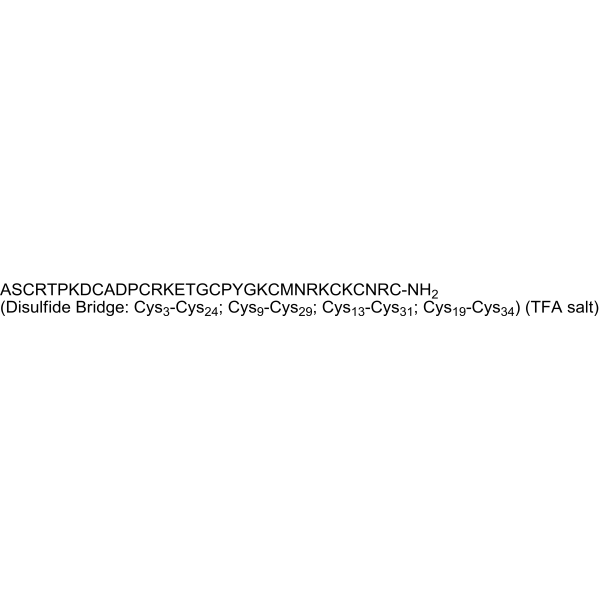
- HY-144801
-
|
|
Potassium Channel
|
Cardiovascular Disease
|
|
DDO-02005 (free base) is a potent Kv1.5 potassium channel inhibitor with an IC50 value of 0.72 μM. DDO-02005 (free base) has good anti-atrial fibrillation (AF) effect in CaCl2-ACh AF rats model and effective anti-arrhythmic activity caused by aconitine .
|
-

- HY-P2785
-
-

- HY-B0189
-
|
TAK-370; AS-4370
|
5-HT Receptor
Cytochrome P450
Potassium Channel
|
Neurological Disease
Cancer
|
|
Mosapride citrate is an orally active gastroenterokinetic compound. Mosapride citrate is a 5HT4agonist. Mosapride citrate is a CYP inducer. Mosapride citrate has a concentration-dependent inhibitory effect on Kv4.3, and its IC50 value is 15.2 μM. Mosapride citrate can be used in the study of gastrointestinal diseases .
|
-

- HY-B0189A
-
|
TAK-370 citrate; AS-4370 citrate
|
5-HT Receptor
Potassium Channel
Cytochrome P450
|
Neurological Disease
Cancer
|
|
Mosapride citrate is an orally active gastroenterokinetic compound. Mosapride citrate is a 5HT4 agonist. Mosapride citrate is a CYP inducer. Mosapride citrate has a concentration-dependent inhibitory effect on Kv4.3, and its IC50 value is 15.2 μM. Mosapride citrate can be used in the study of gastrointestinal diseases .
|
-
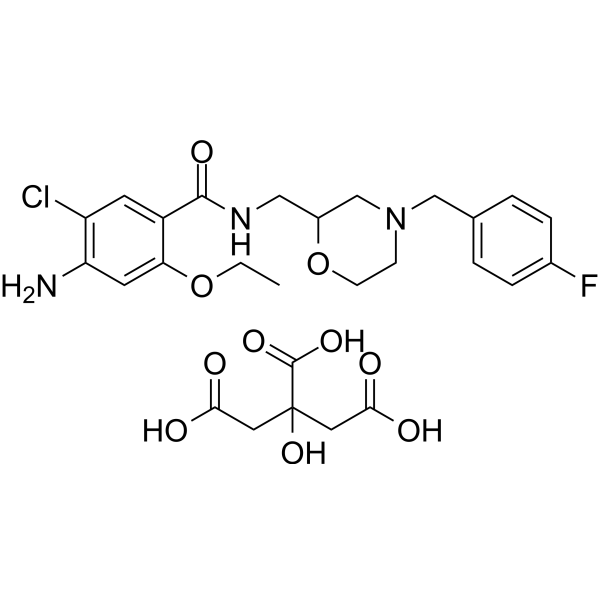
- HY-108591
-
|
R-L3
|
Potassium Channel
|
Cardiovascular Disease
|
|
L-364,373 (R-L3) is a voltage-gated Kv7.1 (KCNQ1)/mink channels activator. L-364,373 activates Iks (slow delayed rectifier potassium current) and shortens action potential duration in guinea pig cardiac myocytes, and suppresses early afterdepolarizations in rabbit ventricular myocytes .
|
-
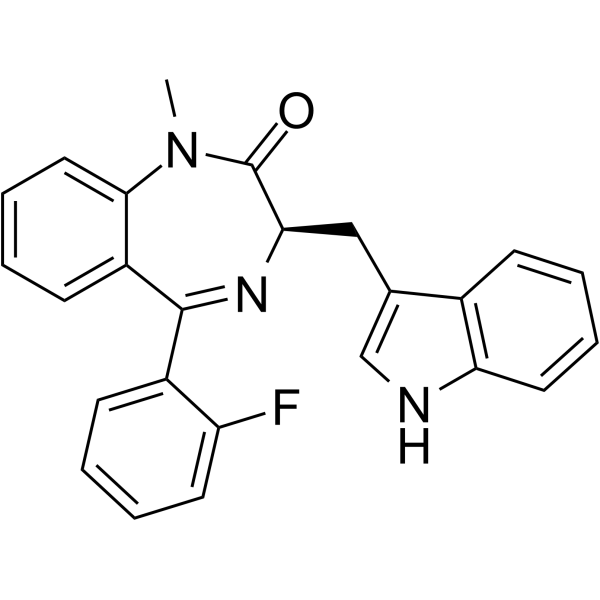
- HY-P5770
-
|
|
Sodium Channel
|
Neurological Disease
|
|
Jingzhaotoxin-V, a 29-residue polypeptide, is derived from the venom of the spider Chilobrachys jingzhao. Jingzhaotoxin-V inhibits tetrodotoxin-resistant and tetrodotoxin-sensitive sodium currents in rat dorsal root ganglion neurons with IC50 values of 27.6 nM and 30.2 nM, respectively. Jingzhaotoxin-V also inhibits Kv4.2 potassium currents expressed in Xenpus Laevis oocytes (IC50 of 604.2 nM) .
|
-

- HY-108590
-
-

- HY-B0189B
-
|
TAK-370 citrate dihydrate; AS-4370 citrate dihydrate
|
5-HT Receptor
Potassium Channel
Cytochrome P450
|
Metabolic Disease
|
|
Mosapride (TAK-370) citrate dehydrate is a gastroprokinetic agent with 5-hydroxytryptamine4 receptor agonist activity and has been widely used in the research of a variety of gastrointestinal disorders. Mosapride citrate dihydrate potently inhibits Kv4.3 in a concentration-dependent manner with IC50 values of 15.2 μM . Mosapride citrate dihydrateselectively stimulates upper GI motility in vivo .
|
-
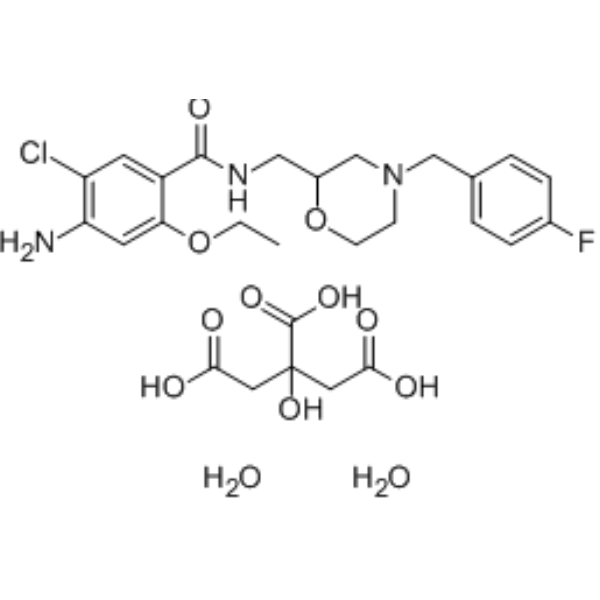
- HY-18063
-
|
|
Potassium Channel
Cytochrome P450
|
Neurological Disease
|
|
ML252 is a selective inhibitor of potassium channel, targeting to KCNQ2 channel (Kv7.2) (IC50=69 nM). ML252 also inhibits Cytochrome P450 with IC50s of 6.1 nM (CYP1A2), 18.9 nM (CYP2C9), 3.9 nM (CYP3A4), 19.9 nM (CYP2D6), respectively .
|
-
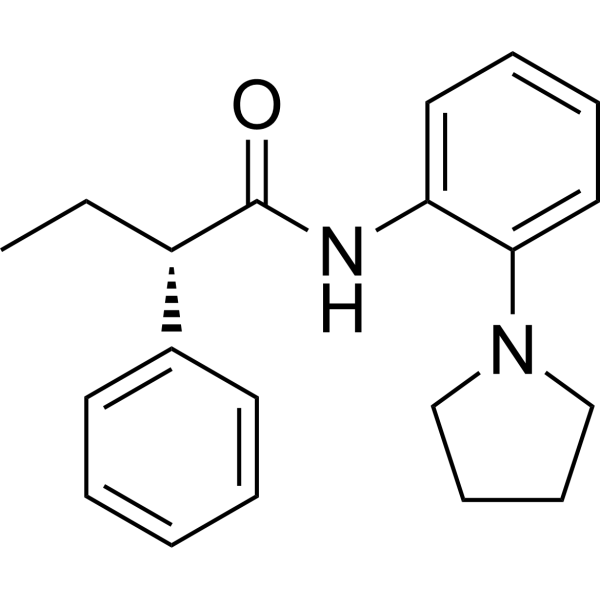
- HY-117825
-
|
|
Potassium Channel
|
Neurological Disease
|
|
RU-TRAAK-2 is a completely reversible TRAAK (TWIK-related arachidonic acid-stimulated K + channel) inhibitor. RU-TRAAK-2 exerts no activity for non-K2P channels (Kv1.2, Slo1 and GIRK2) . RU-TRAAK-2 is a click chemistry reagent, it contains an Alkyne group and can undergo copper-catalyzed azide-alkyne cycloaddition (CuAAc) with molecules containing Azide groups.
|
-
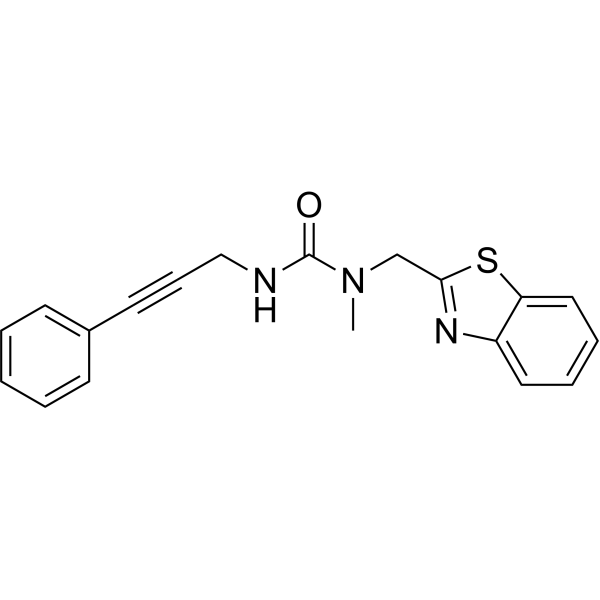
- HY-P3071
-
|
|
Potassium Channel
|
Inflammation/Immunology
|
|
ShK toxin blocks voltage-dependent potassium channel (Kv1.3 channel). ShK toxin can be isolated from the whole body extract of the Caribbean sea anemone (Stichodactylu helianthus). ShK toxin competes with dendrotoxin I and α-dendrotoxin for binding to synaptosomal membranes of rat brain, facilitates acetylcholine release. ShK toxin suppresses K+ currents in cultured rat dorsal root ganglion neurons. ShK toxin also inhibits T lymphocyte proliferation .
|
-

- HY-B0267AS
-
-
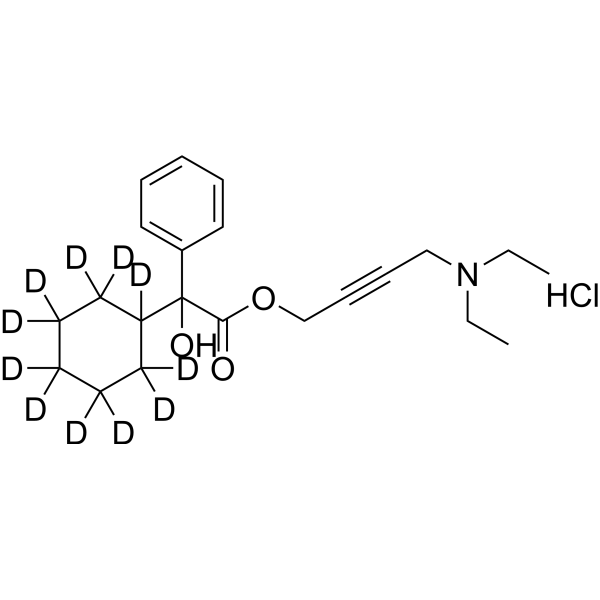
- HY-P1426
-
|
|
Potassium Channel
|
Inflammation/Immunology
|
|
AmmTX3 is a peptide toxin that can be isolated from the venom of the scorpion Androctonus mauretanicus. AmmTX3 is specific blocker of Kv4 channel. AmmTX3 inhibits the A-type K + current (Ki: 131 nM) .
|
-
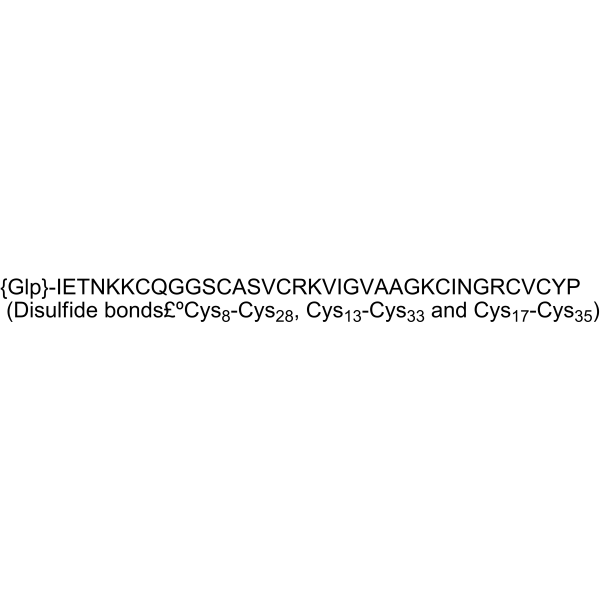
- HY-16953
-
JNJ 303
1 Publications Verification
|
|
|
|
JNJ-303 is a specific delayed rectifier Kv blocker. JNJ 303 can potent block IKs with an IC50 value of 64 nM. JNJ-303 can be used for the research of diabetes, obesity and central nervous system .
|
-
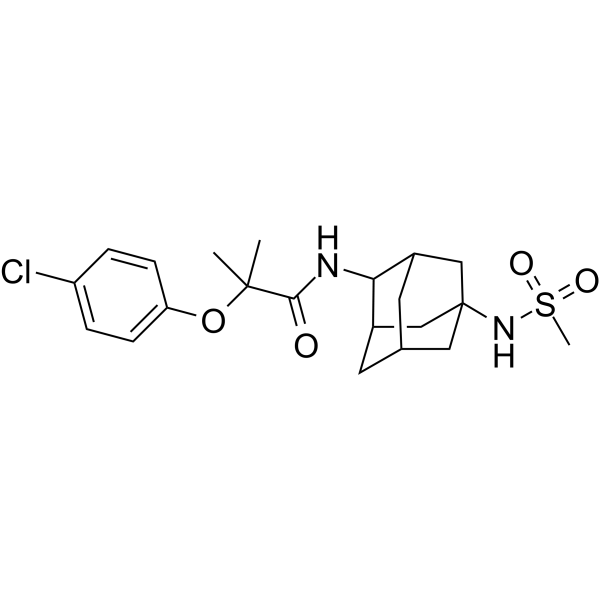
- HY-P1426A
-
|
|
Potassium Channel
|
Inflammation/Immunology
|
|
AmmTX3 TFA is a peptide toxin that can be isolated from the venom of the scorpion Androctonus mauretanicus. AmmTX3 TFA is specific blocker of Kv4 channel. AmmTX3 TFA inhibits the A-type K + current (Ki: 131 nM) .
|
-

- HY-P1441A
-
|
|
Sodium Channel
|
|
|
Mambalgin 1 TFA is a selective ASIC1a inhibitor (IC50 values are 192 and 72 nM for human ASIC1a and ASIC1a/1b dimer, respectively). Mambalgin 1 TFA binds to closed/inactive channel. Mambalgin 1 TFA is selective for ASIC1a over ASIC2a, ASIC3, TRPV1, P2X2, 5-HT3, Nav1.8, Cav3.2 and Kv1.2 channels. Mambalgin 1 TFA increases latency of withdrawal response in mouse tail-flick and paw-flick tests.
|
-
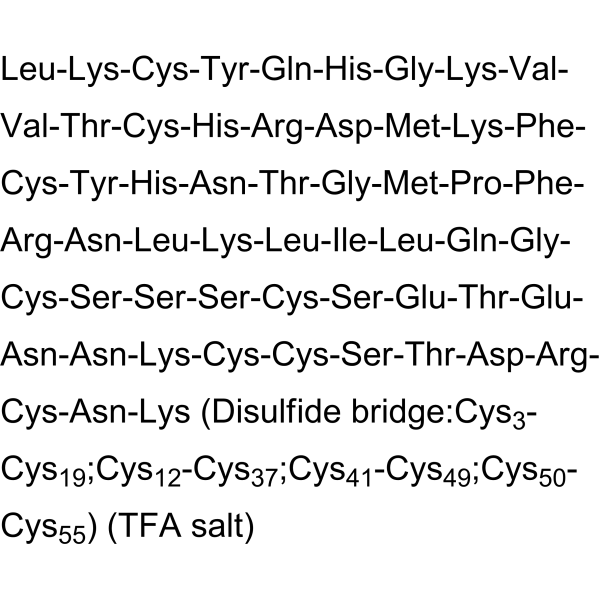
- HY-P1424
-
|
|
Potassium Channel
|
Neurological Disease
|
|
Lei-Dab7 is a potent and selective SK2 (KCa2.2) channels blocker with a Kd of 3.8 nM. Lei-Dab7 shows low or no activity on KCa1, KCa3, Kv and Kir2.1 channels .
|
-
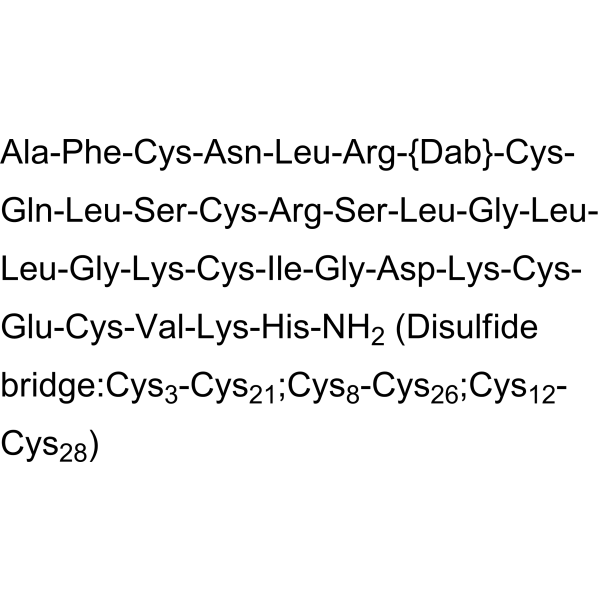
- HY-113673
-
|
|
Potassium Channel
|
Cardiovascular Disease
|
|
A-935142 is a human ether-a-go-go-related gene (hERG, Kv 11.1) channel activator. A-935142 enhances hERG current in a complex manner by facilitation of activation, reduction of inactivation, and slowing of deactivation, and abbreviates atrial and ventricular repolarization .
|
-
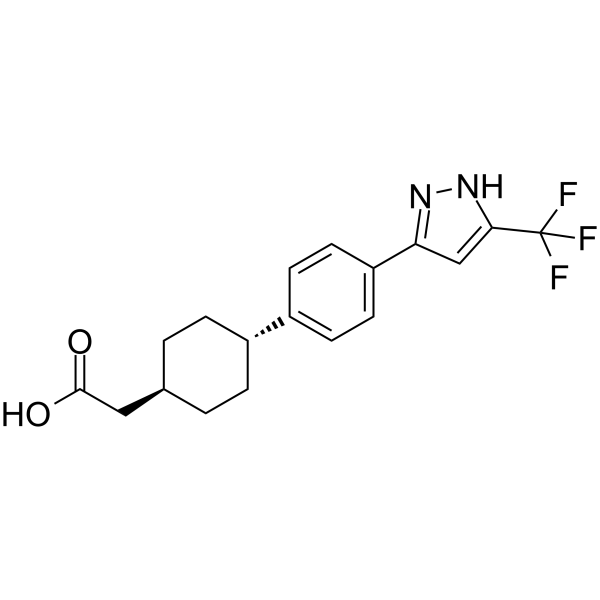
- HY-12343
-
|
CID-53347902
|
Potassium Channel
|
Cardiovascular Disease
|
|
ML277 (CID-53347902) is a potent and selective activator of K(v)7.1 (KCNQ1) potassium channel activator (EC50=270 nM), rescues function of pathophysiologically important mutant channel complexes in human induced pluripotent stem cell-derived cardiomyocytes .
|
-
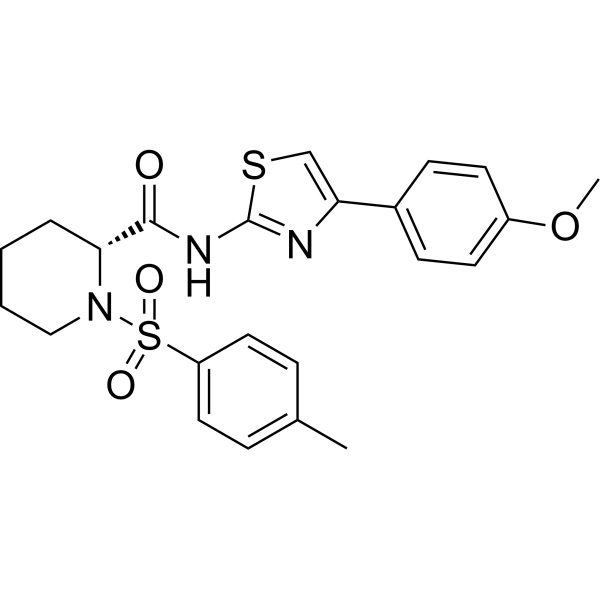
- HY-W020468
-
|
DuP 996
|
Potassium Channel
TRP Channel
|
Neurological Disease
|
|
Linopirdine (DuP 996) is an orally active, selective M-type K + current (IM; Kv7; KCNQ Channels) inhibitor with an IC50 of 2.4 μM. Linopirdine is a TRPV1 agonist. Linopirdine, a putative cognition enhancing agent, increases acetylcholine release in rat brain tissue .
|
-
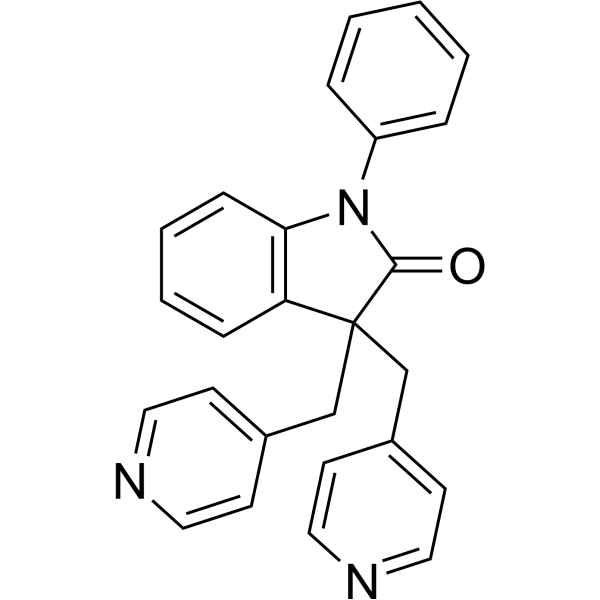
- HY-P1073
-
|
|
Calcium Channel
Sodium Channel
Potassium Channel
|
Cancer
|
|
ProTx-I, a venom toxin of the tarantula Thrixopelma pruriens, is a potent, selective CaV3.1 channel blocker with IC50 values of 0.2 μM and 31.8 μM for hCaV3.1 and hCaV3.2 respectively. ProTx-I is also a potent blocker for voltage-gated Na + channels and inhibits KV 2.1 channels .
|
-
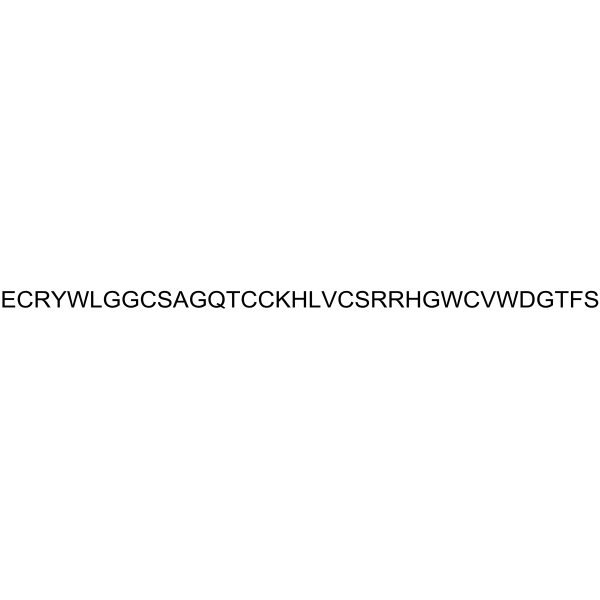
- HY-108578
-
|
|
Potassium Channel
|
Neurological Disease
|
|
RuBi-4AP, a derivative of 4-aminopyridine (4AP; HY-B0604), is a caged Kv channel blocker. RuBi-4AP contains a photolabile protecting group, allowing its effect to be controlled precisely in both space and time with light. RuBi-4AP can be used for the research of neuronal excitability, synaptic transmission, and signal propagation .
|
-

- HY-N1584
-
Halofuginone
Maximum Cited Publications
9 Publications Verification
RU-19110
|
DNA/RNA Synthesis
TGF-beta/Smad
Parasite
Sodium Channel
Calcium Channel
|
Infection
Cardiovascular Disease
Inflammation/Immunology
Cancer
|
|
Halofuginone (RU-19110), a Febrifugine derivative, is a competitive prolyl-tRNA synthetase inhibitor with a Ki of 18.3 nM . Halofuginone is a specific inhibitor of type-I collagen synthesis and attenuates osteoarthritis (OA) by inhibition of TGF-β activity . Halofuginone is also a potent pulmonary vasodilator by activating Kv channels and blocking voltage-gated, receptor-operated and store-operated Ca 2+ channels. Halofuginone has anti-malaria, anti-inflammatory, anti-cancer, anti-fibrosis effects .
|
-

- HY-N1584A
-
|
RU-19110 hydrobromide
|
DNA/RNA Synthesis
TGF-beta/Smad
Parasite
Sodium Channel
Calcium Channel
|
Infection
Cardiovascular Disease
Inflammation/Immunology
Cancer
|
|
Halofuginone (RU-19110) hydrobromid, a Febrifugine derivative, is a competitive prolyl-tRNA synthetase inhibitor with a Ki of 18.3 nM . Halofuginone hydrobromid is a specific inhibitor of type-I collagen synthesis and attenuates osteoarthritis (OA) by inhibition of TGF-β activity . Halofuginone hydrobromid is also a potent pulmonary vasodilator by activating Kv channels and blocking voltage-gated, receptor-operated and store-operated Ca 2+ channels. Halofuginone hydrobromid has anti-malaria, anti-inflammatory, anti-cancer, anti-fibrosis effects .
|
-

- HY-N1584B
-
|
RU-19110 hydrochloride
|
Calcium Channel
DNA/RNA Synthesis
Parasite
Sodium Channel
TGF-beta/Smad
|
Infection
Cardiovascular Disease
Inflammation/Immunology
Cancer
|
|
Halofuginone (RU-19110) hydrobromid, a Febrifugine derivative, is a competitive prolyl-tRNA synthetase inhibitor with a Ki of 18.3 nM. Halofuginone hydrobromid is a specific inhibitor of type-I collagen synthesis and attenuates osteoarthritis (OA) by inhibition of TGF-β activity. Halofuginone hydrobromid is also a potent pulmonary vasodilator by activating Kv channels and blocking voltage-gated, receptor-operated and store-operated Ca 2+ channels. Halofuginone hydrobromid has anti-malaria, anti-inflammatory, anti-cancer, anti-fibrosis effects .
|
-

- HY-P1424A
-
|
|
Potassium Channel
|
|
|
Lei-Dab7 TFA is a high affinity, selective KCa2.2 (SK2) channel blocker (Kd=3.8 nM). Lei-Dab7 TFA exhibits >200-fold selectivity for KCa2.2 over KCa2.1, KCa2.3, KCa3.1, Kv and Kir2.1. Lei-Dab7 TFA increases theta-burst responses and increases LTP in rat hippocampal slices in vitro.
|
-
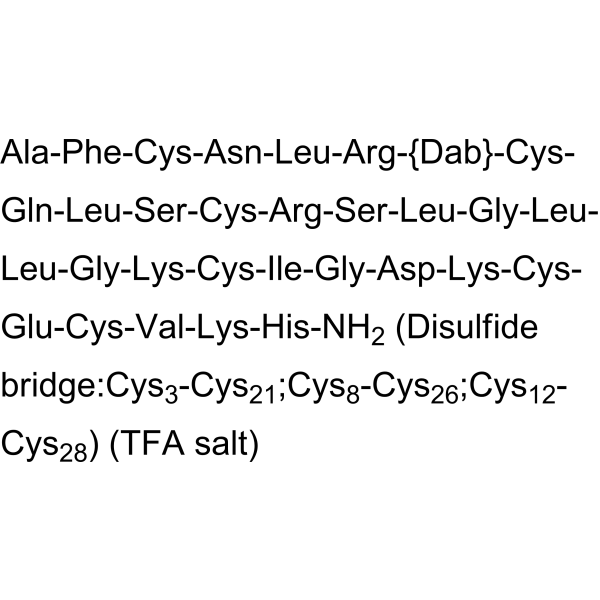
- HY-B0267AR
-
|
|
mAChR
Potassium Channel
|
Neurological Disease
|
|
Oxybutynin (chloride) (Standard) is the analytical standard of Oxybutynin (chloride). This product is intended for research and analytical applications. Oxybutynin chloride is an oral active and competitive mAChR antagonist with Kis of 14.3 and 5.55 nM for specific [ 3H]NMS binding in the mouse bladder and cerebral cortex, respectively. Oxybutynin chloride inhibits vascular Kv channels in a manner independent of anticholinergic effect, with an IC50 value of 11.51 μM. Oxybutynin chloride reduces muscle spasm in the bladder and urinary tract, can be used in study of overactive bladder syndrome (OAB) . Oxybutynin (chloride) is a click chemistry reagent, it contains an Alkyne group and can undergo copper-catalyzed azide-alkyne cycloaddition (CuAAc) with molecules containing Azide groups.
|
-

- HY-152157
-
|
|
HIV
|
Infection
|
|
HIV-1 inhibitor-52 is a potent broad-spectrum HIV-1 activity inhibitor with EC50s of 1.6 nM-6.4 nM for WT HIV-1, HIV-1 V370A, HIV-1 ΔV370, HIV-1 V362I/V370A, HIV-1 T332S/V362I/prR41G, HIV-1 A326T/V362I/V370A, HIV-1 R361K/V362I/L363M .
|
-
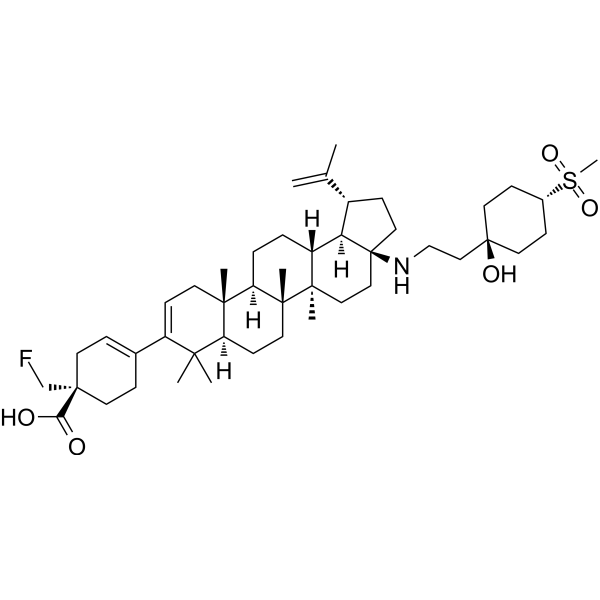
| Cat. No. |
Product Name |
Target |
Research Area |
-
- HY-P1886
-
|
|
Peptides
|
Neurological Disease
|
|
Kv3, Channel Containing Protein (567-585) corresponds to amino acids 567 to 585 fragment of the Kv3.1b channel containing protein. Kv3 channel protein is expressed by parvalbumin (PV)-containing pallidal neurons .
|
-
- HY-P1281
-
|
|
Potassium Channel
|
Neurological Disease
|
|
Kaliotoxin is a peptidyl inhibitor of neuronal BK-Type. Kaliotoxin can specific inhibit Kv channels and calcium-activated potassium channels. Kaliotoxin can be used for the research of the regulation of membrane potential and neuron excitability .
|
-
- HY-P3014
-
|
|
Potassium Channel
|
Others
|
|
Hongotoxin-1, isolated from venom of Centruroides limbatus, is the inhibitor of potassium channel, with IC50 for? Kv1.1, Kv1.2, Kv1.3, and Kv1.6 of 31 pM, 170 pM, 86 pM,and 6000 pM, respectively .
|
-
- HY-P2786A
-
-
- HY-P5788
-
|
|
Potassium Channel
|
Neurological Disease
|
|
Hemitoxin, a scorpion-venom peptide, is a K + channel blocker. Hemitoxin blocks rat Kv1.1, Kv1.2 and Kv1.3 channels expressed in Xenopus oocytes with IC50 values of 13 nM, 16 nM and 2 nM, respectively .
|
-
- HY-P1427
-
|
|
Potassium Channel
|
Neurological Disease
|
|
Guangxitoxin 1E is a potent and selective blocker of KV2.1 and KV2.2 channels. Guangxitoxin 1E inhibits KV2 with an IC50 of 1-3 nM. KV2 channels underlie delayed-rectifier potassium currents in various neurons .
|
-
- HY-P5873
-
|
JZTX-X
|
Potassium Channel
|
Neurological Disease
|
|
Jingzhaotoxin-X (JZTX-X) is a selective Kv4.2 and Kv4.3 potassium channels inhibitor. Jingzhaotoxin-X causes long-lasting mechanical hyperalgesia .
|
-
- HY-P5870
-
|
|
Potassium Channel
|
Inflammation/Immunology
|
|
KTX-Sp2 is a potassium channel toxin. KTX-Sp2 effectively blocks three types of exogenous voltage-gated potassium channels: Kv1.1, Kv1.2 and Kv1.3. Ktx-Sp2 inhibits endogenous Kv1.3 and suppresses Ca 2+ signaling in Jurkat T cells. Ktx-Sp2 inhibits IL-2 secretion from activated Jurkat T cells .
|
-
- HY-P3316
-
|
|
Potassium Channel
|
Neurological Disease
Inflammation/Immunology
|
|
OSK-1 is a potent Kv channel blocker with IC50s of of 0.6 nM, 5.4 nM, 0.014 nM for Kv1.1, Kv1.2 and Kv1.3, respectively. OSK1 is a moderate blocker of Ca 2+-activated KCa3.1 channel with an IC50 of 225 nM. OSK-1 belongs to α-KTx3 toxins and is used as a immunosuppressive agent .
|
-
- HY-P5853
-
|
|
Potassium Channel
|
Inflammation/Immunology
|
|
Aam-KTX is a Kv channel inhibitor with IC50 values of 1.1 nM and >750 nM for Kv1.3 and Kv1.1, respectively. Aam-KTX is a toxic peptide obtained from the venom of the scorpion Mesobuthus eupeus. Aam-KTX has potential in autoimmune diseases research .
|
-
- HY-P3055
-
|
DTX-I
|
Potassium Channel
|
Neurological Disease
Cancer
|
|
Dendrotoxin-I is a potent K + channels blocker and targets voltage-gated potassium channel subunits KV1.1 and KV1.2. Dendrotoxin-I is a neurotoxin isolated from thevenom of Dendroaspis snakes .
|
-
- HY-P1280
-
|
|
Potassium Channel
|
Neurological Disease
|
|
Margatoxin, an alpha-KTx scorpion toxin, is a high affinity inhibitor of Kv1.3 (Kd=11.7 pM). Margatoxin inhibits the Kv1.2 (Kd=6.4 pM) and Kv1.1 (Kd=4.2 nM). Margatoxin, a 39 amino-acid-long peptide, is isolated from the venom of the scorpion Centruroides margaritatus and widely used in ion channel research .
|
-
- HY-P5157
-
|
|
Potassium Channel
|
Neurological Disease
|
|
BmP02 is a selective Kv1.3 channel blocker and a highly-selective Kv4.2 modulator, which can be isolated from Chinese scorpion (Buthus martensi Karsch) venom. BmP02 also delays the inactivation of Kv4.2 in HEK293T cells, with an EC50 value of ~850 nM. BmP02 inhibits the transient outward potassium currents (Ito) in ventricular muscle cells .
|
-
- HY-P1280A
-
|
|
Potassium Channel
|
Neurological Disease
|
|
Margatoxin TFA, an alpha-KTx scorpion toxin, is a high affinity inhibitor of Kv1.3 (Kd=11.7 pM). Margatoxin TFA inhibits the Kv1.2 (Kd=6.4 pM) and Kv1.1 (Kd=4.2 nM). Margatoxin TFA, a 39 amino-acid-long peptide, is isolated from the venom of the scorpion Centruroides margaritatus and widely used in ion channel research .
|
-
- HY-P5155
-
|
|
Potassium Channel
|
Neurological Disease
|
|
Stromatoxin 1 is an inhibitor of Potassium Channel, a peptide which can be isolated from tarantulas. Stromatoxin 1 selectively inhibits K(V)2.1, K(V)2.2, K(V)4.2, and K(V)2.1/9.3 channels. K(V)2.1 and K(V)2.2, but not K(V)4.2, channel subunits play a key role in opposing both myogenic and neurogenic urinary bladder smooth muscle (UBSM) contractions in rats .
|
-
- HY-P1440A
-
|
|
Potassium Channel
|
|
|
BeKm-1 TFA is a potent and selective KV11.1 (hERG) channel blocker. BeKm-1 TFA is selective for KV11.1 over a panel of 14 other potassium channels. BeKm-1 TFA dose-dependently prolongs QTc interval in isolated rabbit heart.
|
-
- HY-P5828
-
-
- HY-P5925
-
|
SsTx Toxin
|
Potassium Channel
|
Inflammation/Immunology
|
|
Ssm Spooky Toxin from?Scolopendra mutilans, exhibits lethal toxicity in hematological and respiratory systems by potently inhibiting KCNQ (voltage-gated potassium channel family 7) channels, with IC50? of 2.8 μM, 5.26 μM and 0.1-0.3 M for Kv7.4, Kv1.3, and Shal channel, respectivily. Ssm Spooky Toxin inhibits cytokine generation by specifically acting on the KV1.3 channel in T cells. Ssm Spooky Toxin plays an essential role in the centipede’s circulatory system .
|
-
- HY-P5771
-
|
|
Sodium Channel
|
Neurological Disease
|
|
Jingzhaotoxin-IX, a C-terminally amidated peptide composed of 35 amino acid residues, is a neurotoxin. Jingzhaotoxin-IX inhibits voltage-gated sodium channels (both tetrodotoxin-resistant and tetrodotoxin-sensitive isoforms) and Kv2.1 channel. Jingzhaotoxin-IX has no effect on delayed rectifier potassium channel Kv1.1, 1.2 and 1.3 .
|
-
- HY-P5818
-
-
- HY-P2785A
-
-
- HY-P1409
-
|
|
Potassium Channel
|
Inflammation/Immunology
|
|
ADWX 1 is a new peptide inhibitor that is potent and selective for Kv1.3 with an IC50 value of 1.89 pM. ADWX 1 inhibits Kv1.3 channel activity specifically to inhibit both the initial calcium signaling and NF-κB activation. ADWX 1 ameliorates the disease in rats of experimental autoimmune encephalomyelitis (EAE) models. ADWX 1 can be used to study T cell-mediated autoimmune diseases .
|
-
- HY-P5871
-
|
JzTx-XII
|
Potassium Channel
|
Others
|
|
Jingzhaotoxin-XII (JzTx-XII) is a specific Kv4.1 channel inhibitor with an IC50 of 0.363 μM. Jingzhaotoxin-XII interacts with the channels by modifying the gating behavior .
|
-
- HY-P5156
-
|
|
Potassium Channel
|
Neurological Disease
|
|
BDS-I known as blood depressing substance, is a marine toxin which can be extracted from Anemonia sulcata. BDS-I is a specific inhibitor of Potassium Channel, targeting to Kv3.4. BDS-I inhibits Aβ1-42-induced enhancement of KV3.4 activity, caspase-3 activation, and abnormal nuclear morphology of NGF-differentiated PC-12 cells. BDS-I reverts the Aβ peptide-induced cell death .
|
-
- HY-P3089
-
|
|
Potassium Channel
|
Others
|
|
Dendrotoxin K is a Kv1.1 channel blocker. Dendrotoxin K determines glutamate release in CA3 neurons in a time-dependent manner through the control of the presynaptic spike waveform .
|
-
- HY-P3089A
-
|
|
Potassium Channel
|
Others
|
|
Dendrotoxin K TFA is a Kv1.1 channel blocker. Dendrotoxin K TFA determines glutamate release in CA3 neurons in a time-dependent manner through the control of the presynaptic spike waveform .
|
-
- HY-P5917
-
|
Vaejovis mexicanus peptide 24
|
Potassium Channel
|
Others
|
|
Vm24-toxin is a toxin peptide that can be isolated from the Mexican scorpion Vaejovis mexicanus smithy. Vm24-toxin is an inhibitor of Kv1.3 potassium channel .
|
-
- HY-P2710
-
|
|
Potassium Channel
|
Neurological Disease
Inflammation/Immunology
|
|
Noxiustoxin is a toxin from the venom of the Mexican scorpion Centruroides noxius which block voltage-dependent potassium channel (Kv1.3, IC50 = 360 nM), and calcium-activated potassium channel. Noxiustoxin plays an important role in neuroinflammatory disease .
|
-
- HY-P5785
-
|
|
Potassium Channel
|
Neurological Disease
|
|
Heteropodatoxin-2, a peptides of 30-amino acid, is a heteropodatoxin. Heteropodatoxin-2 blocks Kv4.2 current expressed in Xenopus laevis oocytes in a voltage-dependent manner, with less block at more positive potentials .
|
-
- HY-P5785A
-
|
|
Potassium Channel
|
Neurological Disease
|
|
Heteropodatoxin-2 (TFA), a peptides of 30-amino acid, is a heteropodatoxin. Heteropodatoxin-2 blocks Kv4.2 current expressed in Xenopus laevis oocytes in a voltage-dependent manner, with less block at more positive potentials .
|
-
- HY-P3507
-
|
ShK-186
|
Potassium Channel
|
Metabolic Disease
Inflammation/Immunology
|
|
Dalazatide (ShK-186) is a specific Kv1.3 potassium channel peptide inhibitor. Dalazatide can be used in the study of autoimmune diseases such as multiple sclerosis (MS), lupus erythematosus, psoriasis, rheumatoid arthritis, type 1 diabetes and inflammatory bowel disease .
|
-
- HY-P5786
-
-
- HY-P3507A
-
|
ShK-186 TFA
|
Potassium Channel
|
Metabolic Disease
Inflammation/Immunology
|
|
Dalazatide (ShK-186) TFA is a specific Kv1.3 potassium channel peptide inhibitor. Dalazatide TFA can be used in the study of autoimmune diseases such as multiple sclerosis (MS), lupus erythematosus, psoriasis, rheumatoid arthritis, type 1 diabetes and inflammatory bowel disease .
|
-
- HY-P5931
-
|
Potassium channel toxin alpha-KTx 6.13; SPX; α-KTx6.13
|
Potassium Channel
|
Inflammation/Immunology
|
|
Spinoxin isolated from the venom of scorpion Heterometrus spinifer, is a 34-residue peptide neurotoxin cross-linked by four disulfide bridges. Spinoxin is a potent inhibitor of Kv1.3 potassium channel (IC50 = 63 nM), considering to be valid molecular targets in the diagnostics and therapy of various autoimmune disorders and cancers .
|
-
- HY-P5182
-
|
|
Potassium Channel
|
Inflammation/Immunology
|
|
HsTX1, from the scorpion Heterometrus spinnifer, is a 34-residue, C-terminally amidated peptide cross-linked by four disulfide bridges. HsTX1, an the inhibitor of potassium channel, with IC50 for Kv1.3 of 12 pM inhibits TEM cell activation and attenuates inflammation in autoimmunity .
|
-
- HY-P5182A
-
|
|
Potassium Channel
|
Inflammation/Immunology
|
|
HsTX1 (TFA) toxin, from the scorpion Heterometrus spinnifer, is a 34-residue, C-terminally amidated peptide cross-linked by four disulfide bridges. HsTX1 (TFA) is an the inhibitor of potassium channel, with IC50 for Kv1.3 of 12 pM and inhibits TEM cell activation and attenuates inflammation in autoimmunity .
|
-
- HY-P2785
-
-
- HY-P5770
-
|
|
Sodium Channel
|
Neurological Disease
|
|
Jingzhaotoxin-V, a 29-residue polypeptide, is derived from the venom of the spider Chilobrachys jingzhao. Jingzhaotoxin-V inhibits tetrodotoxin-resistant and tetrodotoxin-sensitive sodium currents in rat dorsal root ganglion neurons with IC50 values of 27.6 nM and 30.2 nM, respectively. Jingzhaotoxin-V also inhibits Kv4.2 potassium currents expressed in Xenpus Laevis oocytes (IC50 of 604.2 nM) .
|
-
- HY-P3071
-
|
|
Potassium Channel
|
Inflammation/Immunology
|
|
ShK toxin blocks voltage-dependent potassium channel (Kv1.3 channel). ShK toxin can be isolated from the whole body extract of the Caribbean sea anemone (Stichodactylu helianthus). ShK toxin competes with dendrotoxin I and α-dendrotoxin for binding to synaptosomal membranes of rat brain, facilitates acetylcholine release. ShK toxin suppresses K+ currents in cultured rat dorsal root ganglion neurons. ShK toxin also inhibits T lymphocyte proliferation .
|
-
- HY-P1426
-
|
|
Potassium Channel
|
Inflammation/Immunology
|
|
AmmTX3 is a peptide toxin that can be isolated from the venom of the scorpion Androctonus mauretanicus. AmmTX3 is specific blocker of Kv4 channel. AmmTX3 inhibits the A-type K + current (Ki: 131 nM) .
|
-
- HY-P1426A
-
|
|
Potassium Channel
|
Inflammation/Immunology
|
|
AmmTX3 TFA is a peptide toxin that can be isolated from the venom of the scorpion Androctonus mauretanicus. AmmTX3 TFA is specific blocker of Kv4 channel. AmmTX3 TFA inhibits the A-type K + current (Ki: 131 nM) .
|
-
- HY-P1441A
-
|
|
Sodium Channel
|
|
|
Mambalgin 1 TFA is a selective ASIC1a inhibitor (IC50 values are 192 and 72 nM for human ASIC1a and ASIC1a/1b dimer, respectively). Mambalgin 1 TFA binds to closed/inactive channel. Mambalgin 1 TFA is selective for ASIC1a over ASIC2a, ASIC3, TRPV1, P2X2, 5-HT3, Nav1.8, Cav3.2 and Kv1.2 channels. Mambalgin 1 TFA increases latency of withdrawal response in mouse tail-flick and paw-flick tests.
|
-
- HY-P1424
-
|
|
Potassium Channel
|
Neurological Disease
|
|
Lei-Dab7 is a potent and selective SK2 (KCa2.2) channels blocker with a Kd of 3.8 nM. Lei-Dab7 shows low or no activity on KCa1, KCa3, Kv and Kir2.1 channels .
|
-
- HY-P5916
-
|
κ-Theraphotoxin-Gr4a; Kappa-TRTX-Gr4a; Voltage sensor toxin 3; Peptide F
|
Peptides
|
Neurological Disease
|
|
VSTx-3 is a KV channel blocker. VSTx-3 is demonstrated to be a potent, TTX-sensitive sodium channel blocker and especially, a potent blocker of NaV1.8 channels (IC50 0.19 μM for hNaV1.3, 0.43 μM for hNaV1.7 and 0.77 μM for hNaV1.8 channels).
|
-
- HY-P1073
-
|
|
Calcium Channel
Sodium Channel
Potassium Channel
|
Cancer
|
|
ProTx-I, a venom toxin of the tarantula Thrixopelma pruriens, is a potent, selective CaV3.1 channel blocker with IC50 values of 0.2 μM and 31.8 μM for hCaV3.1 and hCaV3.2 respectively. ProTx-I is also a potent blocker for voltage-gated Na + channels and inhibits KV 2.1 channels .
|
-
- HY-P1424A
-
|
|
Potassium Channel
|
|
|
Lei-Dab7 TFA is a high affinity, selective KCa2.2 (SK2) channel blocker (Kd=3.8 nM). Lei-Dab7 TFA exhibits >200-fold selectivity for KCa2.2 over KCa2.1, KCa2.3, KCa3.1, Kv and Kir2.1. Lei-Dab7 TFA increases theta-burst responses and increases LTP in rat hippocampal slices in vitro.
|
| Cat. No. |
Product Name |
Category |
Target |
Chemical Structure |
| Cat. No. |
Compare |
Product Name |
Species |
Source |
Compare Products
|
| Products |
|
| Cat. No. |
|
| Species |
|
| Source |
|
| Tag |
|
| Accession |
|
| Gene ID |
|
| Molecular Weight |
|
| Purity |
|
| Endotoxin Level |
|
| Biological Activity |
|
| Appearance |
|
| Formulation |
|
| Storage & Stability |
|
| Shipping |
|
| Free Sample |
Yes
No
|
| Size |
* This product has been "discontinued".
Optimized version of product available:
|
| Cat. No. |
Product Name |
Chemical Structure |
-
- HY-B0267AS
-
|
|
|
Oxybutynin-d11 (chloride) is the deuterium labeled Oxybutynin chloride. Oxybutynin chloride is an anticholinergic agent, which inhibits vascular Kv channels in a concentration-dependent manner, with an IC50 of 11.51 μM[1].
|
-

| Cat. No. |
Product Name |
Application |
Reactivity |
-
- HY-P83330
-
|
KCNA1; Potassium voltage-gated channel subfamily A member 1; Voltage-gated K(+) channel HuKI; Voltage-gated potassium channel HBK1; Voltage-gated potassium channel subunit Kv1.1
|
WB, IP
|
Human |
Your information is safe with us. * Required Fields.
Inquiry Information
- Product Name:
- Cat. No.:
- Quantity:
- MCE Japan Authorized Agent:


















































































































